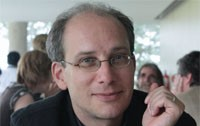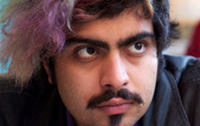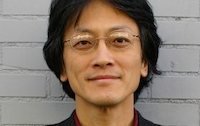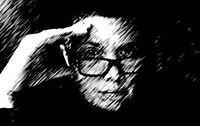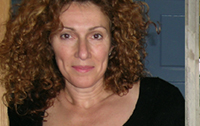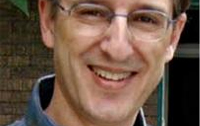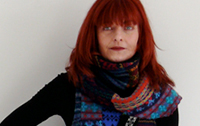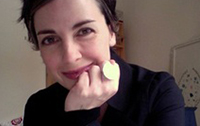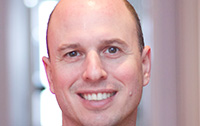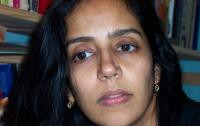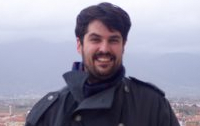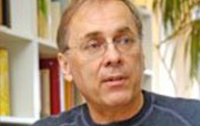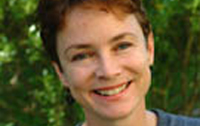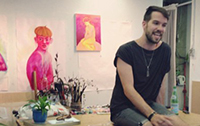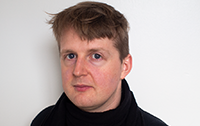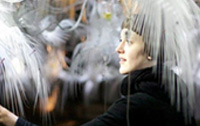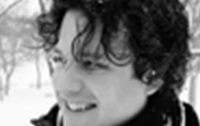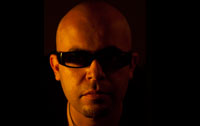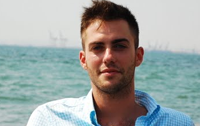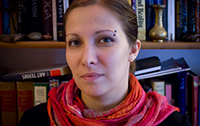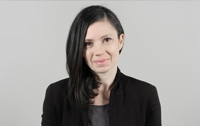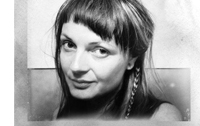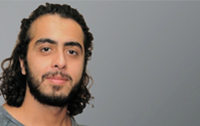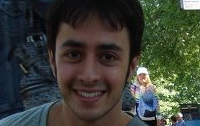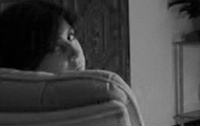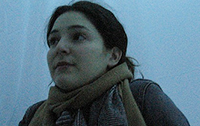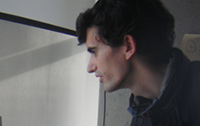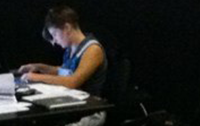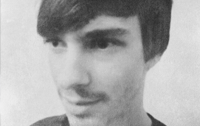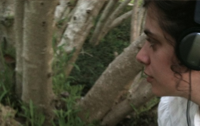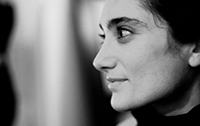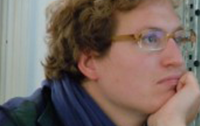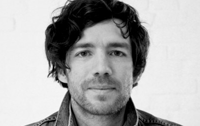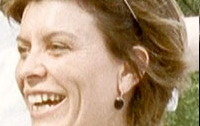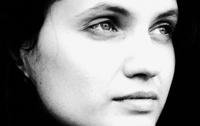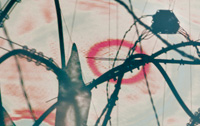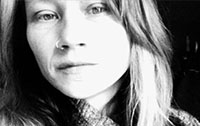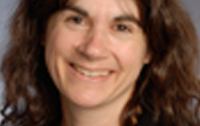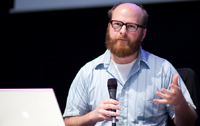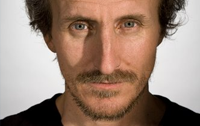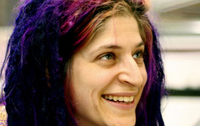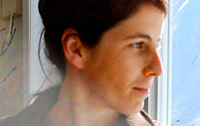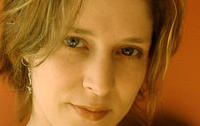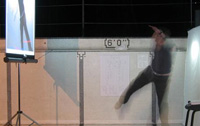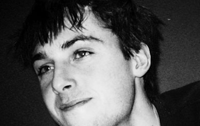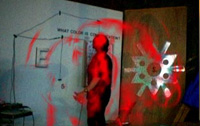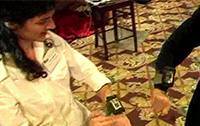Directors
Michael Montanaro
Associate Director of the Topological Media Lab
Chair of the Department of Contemporary Dance Concordia University
Graduate of Hartford Conservatory - former Assistant Artistic Director of le Groupe de la Place Royale - founder and choreographer of Montanaro Dance – has choreographed for a number of companies such as Winnipeg Contemporary Dancers, Danse Partout, the National Film Board of Canada, l’Opéra de Montréal - collaborated on video sensing systems to create interactive works at the “Institute for Studies in the Arts”, Arizona State University - has travelled world-wide as a consultant for an interactive image museum project based in Portugal. - Choreographer for Varekai, a Cirque du Soleil production.
Michael has a background that has crossed the boundaries of many different art forms. Accomplished as a composer, musician, actor and trans-disciplinary artist, he is best known for his work in the field of dance.
David Morris
Associate Director of the Topological Media Lab
Chair of the Philosophy Department
PhD: The University of Toronto (1997)
MA: The University of Toronto (1992)
BA: The University of Toronto (1991)
My main interests are in Continental Philosophy (especially Phenomenology, Merleau-Ponty and Bergson) and Hegel, with a focus on the philosophy of the body, mind and nature in relation to current biology and cognitive science. I am currently studying the problem of the genesis of meaning and sense, in relation to biological and perceptual phenomena. My most recent publications are on: reversibility, expression, perception, animals, faces, embryology and ontology in Merleau-Ponty; organisms in Kant; embodied cognition; animals and humans, in relation to the problem of mind and body; method in Husserl, Bergson, and Peirce. My book The Sense of Space was published by SUNY Press in 2004.
Associate Director in Responsive Media
Navid Navab
Navid Navab | navidnavab.net | is a Montreal based composer, media alchemist, audio-visual sculptor, perSonifier, gestureBender, phono-menologist, and all around multidisciplinary artist.
Interested in the poetics of schizophonia, materiality, and embodiment, his work investigates the transmutation of matter and the enrichment of its inherent performative qualities. Making the imperceptible palpable, Navid uses gestures, rhythms and vibration from everyday life as basis for real-time compositions, resulting in augmented acoustical-poetry and painterly light that enchants improvisational and pedestrian movements. A graduate of Ontario Royal Conservatory of Music, Concordia University’s Electroacoustics and Computational Arts program, and McGill Music Technology, Navid has been leading experiments for the past several years creating deeply expressive intermedia instruments synthesizing his research at IRCAM, CRIMMT, CNMAT, Topological Media Lab and Matralab, while using phenomenological studies to inform the creation of computationally-augmented performance environments.
His pieces, which which take on the form of gestural sound compositions, responsive architecture, site specific interventions, theatrical interactive installations, kinetic sound sculptures and multimodal improv-based performances, have been presented internationally at diverse venues including Canadian Center for Architecture, Festival du Nouveau Cinema, eArts Shanghai, MUMUTH Austria, Roulette New York, Western Front Vancouver, McCord Museum, Musée d’art Contemporain de Montréal, Timisoara Romania, Contemporary Arts Museum Houston, International Digital Arts Biennial, Musiikin Aika Finland, HKW Berlin, Festival International Montréal/Nouvelles Musiques, Suoni Per il Popolo Festival, CURRENTS Santa Fe, CCRMA Palo Alto, CINARS Biennale, Electric Eclectics Meaford, and TANGENTE mtl among others.
His currently ongoing decade long series such as Practices of Everyday Life, and GestureBending interventions reflect Navid’s continued interest in the enactment of dynamic performative ecologies that allow for poetic and virtuosic improvisation with computationally enriched materials and environments.
“Underlying this array imaginative creations is a playful awareness of the relationship between gesture, materiality, and sound. By enchanting the inherent properties of materials we know from everyday life with potential for play, Navid reacquaints us with the magic and wonder of our embodied experience.”
-Rachel Elliott, international institute for critical studies in improvisation
Founder
Sha Xin Wei
Canada Research Chair, Media Arts and Sciences
Associate Professor // Fine Arts and Computer Science // Concordia University
Sha Xin Wei, Ph.D., is Canada Research Chair in media arts and sciences, and Associate Professor of Fine Arts and Computer Science at Concordia University in Montréal, Canada. He directs the Topological Media Lab, a studio-laboratory for the study of gesture and materiality from computational and phenomenological perspectives. Sha’s art research works include the TGarden responsive environments, Hubbub speech-sensitive urban surfaces, Membrane calligraphic video, Softwear gestural sound instruments, the WYSIWYG sounding tapestry.
Sha Xin Wei was trained in mathematics at Harvard and Stanford Universities, and worked more than 12 years in the fields of scientific computation, mathematical modeling and the visualization of scientific data and geometric structures.
In 1995, he extended his work to network media authoring systems and media theory coordinating a 3 year long workshop on interaction and computational media at Stanford. In 1997, he co-founded Pliant Research with colleagues from Xerox PARC and Apple Research Labs, dedicated to designing technologies that people and organizations can robustly reshape to meet evolving socio-economic needs.
In 1998, Sha also co-founded the Sponge art group in San Francisco, to build public experiments in phenomenology of performance. With Sponge and other artists, Sha Xin Wei directed event /installations in prominent experimental art venues including Ars Electronica Austria, V2 The Netherlands, MediaTerra Greece, Banff Canada, Future Physical United Kingdom, and Elektra Montréal. He has also exhibited media installations at Postmasters Gallery New York and Suntrust Gallery Atlanta. These works have been recognized by awards from major cultural foundations such as the Daniel Langlois Foundation for Art, Science and Technology; the LEF Foundation; the Canada Fund for Innovation; the Creative Work Fund in New York; and the Rockefeller Foundation.
After obtaining an interdisciplinary Ph.D. in 2001 at Stanford on differential geometric performance and the technologies of writing in Mathematics, Computer Science, and History & Philosophy of Science, Sha joined the faculty of the School of Literature, Communication and Culture at the Georgia Tech in Atlanta, and the research faculty in the Graphics, Visualization and Usability Center in the College of Computing, where he founded the Topological Media Lab.
In 2004-2005, Dr. Sha was Visiting Scholar in History of Science at Harvard University, and the Program in Science, Technology, and Society at MIT, writing about agency, materiality, performance, and topological media. In 2005, Dr. Sha became director of Hexagram’s Active Textiles and Wearable Computers Axis.
Dr. Sha is a co-editor of the journal, Artificial Intelligence and Society. Publications include the essays “Resistance is Fertile: Gesture and Agency in the Field of Responsive Media,” Configurations 2003, “Demonstrations of Expressive Softwear and Ambient Media,” Ubicomp 2003, and to appear in 2005-2006: “Whitehead’s Poetical Mathematics,” in Configurations, “TGarden As Experimental Performance,” in Modern Drama, and “A Poetics of Performative Space,” in Poetics Today. He is now writing a book on poiesis and enchantment in topological matter.
Associate Researcher in Performance Design
Shauna Janssen
Shauna is a Montreal based urban curator with a background in professional theatre practice and interdisciplinary studies. Her curatorial work involves long-term documentary and site-responsive urban research projects. Within the context of urban change, in her curatorial practice she works with artists to create site responsive performances, interventions, installations, and collaborative community engaged projects. In her practice she asks how critical curation can be a mode of intervention in the urban realm, and how urban spaces in transition might be active collaborators, with artists, in the surfacing of significant pasts, sublimated political positions, and forms of cultural agency, including the agencies of the built environment itself. Shauna works with oral history, critical post humanist thought, performance, feminist and queer theory to rethink sites, discourses, and themes such as spatial agency, the public sphere, gender, class, race, gentrification and the right to the city. Her ongoing research addresses the cultural politics of postindustrial urban spaces, and the role of art/ists in creating politically engaged communities in these spaces. She is currently undertaking research on the role of digital and new media in the public sphere in relation to expanded scenographic practices and concepts such as spatial dramaturgy and performative urbanism.
Shauna received her PhD in Humanities (2014), Centre for Interdisciplinary Studies in Society and Culture at Concordia University, where she has also taught in the Departments of Theatre and Art History. In 2010, she founded Urban Occupations Urbaines, a curatorial platform for artists, communities and the public to creatively and critically engage with cities and urban change. In Montreal, she has collaborated with La Fonderie Darling, Heritage Montréal, Centaur Theatre, Montréal Arts Interculturel, Le Corridor culturel de Griffintown, Parks Canada, and the Centre d’histoire de Montréal. She is a founding member and formerly co-director of Points de vue, a Montreal based community-engaged art, research, and urban activist platform. She has given public lectures and presentations at cultural institutions such as the Canadian Centre for Architecture (Ephemeral City, 2010), Articule (“Would you be my curator?” 2012), and The McCord Museum (City Talks, 2013). In 2014 she was the associate producer for international bi-annual event Encuentro IX. Shauna is an affiliate member of the Centre for Oral History and Digital Storytelling Concordia University. Since 2006, she has been a guest instructor at the National Theatre School of Canada.
Affiliate Faculty
Paul Shrivastava
Dr. Paul Shrivastava is the David O’Brien Distinguished Professor of Sustainable Enterprise at the John Molson School of Business, Concordia University, Montreal. He also serves as Senior Advisor on sustainability at Bucknell University and the Indian Institute of Management-Shillong, India. In addition, he serves on the Board of Trustees of DeSales University, Allentown, Pennsylvania.
Dr. Shrivastava received his Ph. D. from the University of Pittsburgh. He was tenured Associate Professor of Management at the Stern School of Business, New York University. He has published 15 books and over 100 articles in professional and scholarly journals. He served on the editorial boards of leading management education journals including the Academy of Management Review, the Strategic Management Journal, Organization, Risk Management, and Business Strategy and the Environment. He won a Fulbright Senior Scholar Award and studied Japanese management while based at Kyoto University. He founded the Organization and Natural Environment Division of the Academy of Management. His work has been featured in the Los Angeles Times, the Philadelphia Inquirer, the Christian Science Monitor, and on the McNeil-Lehrer News Hour.
Dr. Shrivastava has 30 years experience in management education, entrepreneurship, and as a consultant to major multinational companies. In 1976 he was part of the management team that launched Hindustan Computers Ltd., one of India’s largest computer companies. In 1985 he founded the non-profit Industrial Crisis Institute, Inc. to mediate the industrial crisis between Union Carbide Corporation and the Government of India, and published the Industrial Crisis Quarterly. In 1998 he founded, and was President and CEO of eSocrates, Inc., a knowledge management and online training/education software company. He has served as consultant to AT & T, Baker Hughes, FMC Corp, Johnson and Johnson, Ketchum Communications, Scott Paper, Wartsila, Oy, and MEC RASTOR, and Elea-Olivetti. He designs and presents strategic summits and training workshops for upper management focused on corporate and competitive strategy, sustainable management, and crisis management.
He was co-organizer of the Steelman Triathlon races and DJed the World Tango Music show on WVBU, 90.5FM, Lewisburg, PA.
Want to learn even more about Dr. Shrivastava? Visit his website…
Carmela Cucuzzella
Carmela Cucuzzella
Assistant Professor, Design and Computation Arts at Concordia University
- PhD (Environmental Design), Université de Montréal
- MAppSc (Design and Complexity), Université de Montréal
- BFA (Design Arts), Concordia University
- BCompSc (Systems Architecture), Concordia University
Carmela Cucuzzella’s research interests lie predominantly in responsible design practices with a particular interest in understanding the challenges of accommodating sustainability diagnostic or rating tools such as Life Cycle Assessment (LCA) and LEED (Leadership in Energy and Environmental Design) alongside the creative conceptual exploration that takes place during the design process. She addresses the limits of current sustainability assessment tools as a means to gain a complex understanding of social, cultural and environmental repercussions of design practice. Prior to joining Concordia University, she was employed by Bell Northern Research (later Nortel Networks) for eleven years where she designed and developed software for the telecommunications industry. During her PhD studies, Carmela served as Research Project Manager for the Laboratoire d’étude d’architecture potentielle at UdeM. She has presented over twenty communications and published in books and international journals on environmental, social and cultural issues related to assessment and judgment for design projects, in the context of sustainability. She has already served as a guest lecturer in our department, including in DART 448, Ecology and 3D Design and has taught at Université de Québec a Montréal (UQAM).
research interests: Design for sustainability, design thinking, evaluation and judgment, precautionary principle, dichotomy between prevention and precaution for design for sustainability, complexity, systems design
areas of expertise: Environmental and social Life Cycle Analysis, LEED
Ricardo Dal Farra
Associate Professor im Music at Concordia University
Dr. Ricardo Dal Farra has been conducting activities in the merging fields of arts, sciences and new technologies as a composer and multimedia artist, researcher, educator, performer and curator focusing mainly on electroacoustic music and new media arts for more than 25 years. Dr. Dal Farra holds a PhD inEtudes et pratiques des arts from Université du Québec à Montréal.
pk Langshaw
pk langshaw
Professor at Concordia University
Directrice of d_verse Lab
pk langshaw is the directrice of the d_verse lab at hexagram/concordia institute for research/creation in media arts and technologies. In the lab we investigate where poetic introspection intersects with a hybrid prax- is that of verse- diverse, reverse, inversion, transversal, and reversible. The research/creation works are informed by design/art and science and situated as sociological projects. The content is mediated by forms of sensor controlled environments, garments, video, photography, real time interfaces and adaptive screen projections.
Sustainability including the three main tenets: ecological, socio-cultural and economic is studied and utilized in specific technological contexts, material form, as a unified strategy for nomadic performance environments. The internet as social media, network and/ or democratic site of communication, interaction and display is of particular interest.
http://www.pklangshaw.com
http://d_verse.hexagram.ca/index.html
http://design.concordia.ca/publicart
Paul Shrivastava
Dr. Paul Shrivastava is the David O’Brien Distinguished Professor of Sustainable Enterprise at the John Molson School of Business, Concordia University, Montreal. He also serves as Senior Advisor on sustainability at Bucknell University and the Indian Institute of Management-Shillong, India. In addition, he serves on the Board of Trustees of DeSales University, Allentown, Pennsylvania.
Dr. Shrivastava received his Ph. D. from the University of Pittsburgh. He was tenured Associate Professor of Management at the Stern School of Business, New York University. He has published 15 books and over 100 articles in professional and scholarly journals. He served on the editorial boards of leading management education journals including the Academy of Management Review, the Strategic Management Journal, Organization, Risk Management, and Business Strategy and the Environment. He won a Fulbright Senior Scholar Award and studied Japanese management while based at Kyoto University. He founded the Organization and Natural Environment Division of the Academy of Management. His work has been featured in the Los Angeles Times, the Philadelphia Inquirer, the Christian Science Monitor, and on the McNeil-Lehrer News Hour.
Dr. Shrivastava has 30 years experience in management education, entrepreneurship, and as a consultant to major multinational companies. In 1976 he was part of the management team that launched Hindustan Computers Ltd., one of India’s largest computer companies. In 1985 he founded the non-profit Industrial Crisis Institute, Inc. to mediate the industrial crisis between Union Carbide Corporation and the Government of India, and published the Industrial Crisis Quarterly. In 1998 he founded, and was President and CEO of eSocrates, Inc., a knowledge management and online training/education software company. He has served as consultant to AT & T, Baker Hughes, FMC Corp, Johnson and Johnson, Ketchum Communications, Scott Paper, Wartsila, Oy, and MEC RASTOR, and Elea-Olivetti. He designs and presents strategic summits and training workshops for upper management focused on corporate and competitive strategy, sustainable management, and crisis management.
He was co-organizer of the Steelman Triathlon races and DJed the World Tango Music show on WVBU, 90.5FM, Lewisburg, PA.
Want to learn even more about Dr. Shrivastava? Visit his website…
Carmela Cucuzzella
Carmela Cucuzzella
Assistant Professor, Design and Computation Arts at Concordia University
- PhD (Environmental Design), Université de Montréal
- MAppSc (Design and Complexity), Université de Montréal
- BFA (Design Arts), Concordia University
- BCompSc (Systems Architecture), Concordia University
Carmela Cucuzzella’s research interests lie predominantly in responsible design practices with a particular interest in understanding the challenges of accommodating sustainability diagnostic or rating tools such as Life Cycle Assessment (LCA) and LEED (Leadership in Energy and Environmental Design) alongside the creative conceptual exploration that takes place during the design process. She addresses the limits of current sustainability assessment tools as a means to gain a complex understanding of social, cultural and environmental repercussions of design practice. Prior to joining Concordia University, she was employed by Bell Northern Research (later Nortel Networks) for eleven years where she designed and developed software for the telecommunications industry. During her PhD studies, Carmela served as Research Project Manager for the Laboratoire d’étude d’architecture potentielle at UdeM. She has presented over twenty communications and published in books and international journals on environmental, social and cultural issues related to assessment and judgment for design projects, in the context of sustainability. She has already served as a guest lecturer in our department, including in DART 448, Ecology and 3D Design and has taught at Université de Québec a Montréal (UQAM).
research interests: Design for sustainability, design thinking, evaluation and judgment, precautionary principle, dichotomy between prevention and precaution for design for sustainability, complexity, systems design
areas of expertise: Environmental and social Life Cycle Analysis, LEED
Ricardo Dal Farra
Associate Professor im Music at Concordia University
Dr. Ricardo Dal Farra has been conducting activities in the merging fields of arts, sciences and new technologies as a composer and multimedia artist, researcher, educator, performer and curator focusing mainly on electroacoustic music and new media arts for more than 25 years. Dr. Dal Farra holds a PhD inEtudes et pratiques des arts from Université du Québec à Montréal.
pk Langshaw
pk langshaw
Professor at Concordia University
Directrice of d_verse Lab
pk langshaw is the directrice of the d_verse lab at hexagram/concordia institute for research/creation in media arts and technologies. In the lab we investigate where poetic introspection intersects with a hybrid prax- is that of verse- diverse, reverse, inversion, transversal, and reversible. The research/creation works are informed by design/art and science and situated as sociological projects. The content is mediated by forms of sensor controlled environments, garments, video, photography, real time interfaces and adaptive screen projections.
Sustainability including the three main tenets: ecological, socio-cultural and economic is studied and utilized in specific technological contexts, material form, as a unified strategy for nomadic performance environments. The internet as social media, network and/ or democratic site of communication, interaction and display is of particular interest.
http://www.pklangshaw.com
http://d_verse.hexagram.ca/index.html
http://design.concordia.ca/publicart
Cynthia Hammond
Dr. Cynthia Hammond
Associate Professor at Concordia University
Chair of the Department of Art History
Hammond graduated from Concordia University’s Interdisciplinary Doctoral Program in 2002. Her dissertation won the Governor-General’s Gold Medal for a doctoral dissertation. From 2003-05, Hammond held a SSHRC-funded postdoctoral fellowship at the School of Architecture, McGill University. She taught for several departments of art history and schools of architecture in Canada before returning to Concordia in 2006. A practising artist, Hammond’s work is often founded upon interdisciplinary practices of archival research, artistic production and community engagement.
www.cynthiahammond.com
www.pouf.ca
http://cityaspalimpsest.concordia.ca/
Jeremy Cooperstock
Jeremy Cooperstock (Ph.D., University of Toronto, 1996) is an associate professor in the department of Electrical and Computer Engineering, a member of the Centre for Intelligent Machines, and a founding member of the Centre for Interdisciplinary Research in Music Media and Technology at McGill University. He directs the Shared Reality Lab, which focuses on computer mediation to facilitate high-fidelity human communication and the synthesis of perceptually engaging, multimodal, immersive environments, and also leads the theme of Enabling Technologies for a Networks of Centres of Excellence on Graphics, Animation, and New Media (GRAND). Cooperstock’s accomplishments include theIntelligent Classroom, the world’s first Internet streaming demonstrations of Dolby Digital 5.1, uncompressed 12-channel 96kHz/24bit, multichannel DSD audio, and multiple simultaneous streams of uncompressed high-definition video, and a simulation environment that renders graphic, audio, and vibrotactile effects in response to footsteps. His work on the Ultra-Videoconferencing system was recognized by an award for Most Innovative Use of New Technology from ACM/IEEE Supercomputing and a Distinction Award from the Audio Engineering Society. Cooperstock has worked with IBM at the Haifa Research Center, Israel, and the T.J. Watson Research Center in Yorktown Heights, New York, the Sony Computer Science Laboratory in Tokyo, Japan, and was a visiting professor at Bang & Olufsen, Denmark, where he conducted research on telepresence technologies as part of the World Opera Project. He chaired the Audio Engineering Society (AES) Technical Committee on Network Audio Systems from 2001 to 2009 and is currently an associate editor of the Journal of the AES.
Affiliation:
Kavita Philip
University of California Irvine
Kavita Philip is Associate Professor of Women’s Studies at the University of California, Irvine. She works in the field of Science and Technology Studies. Her current research areas are environmental history; postcolonial and feminist science studies; globalization;
new media technologies.
Her articles in environmental history, globalization, and new media studies have appeared in the journals Cultural Studies, Postmodern Culture, NMediaC, and Environment and History. She has recently published a monograph on the history of colonial science in south India: Civilizing Natures, Rutgers University Press. She is working on a new manuscript, co-authored with Terry Harpold, entitled Going Native: Cyberculture and the Millennial Fantasies of Globalization (forthcoming, Routledge).
In her capacity as Affiliate Scholar, Prof. Philip is interested in the creation of metaphors for thinking in technoscientific contexts. Historians of science have long known that metaphors are indispensable parts of investigation and explanation, and that the richness and squishiness of metaphors have long challenged simple correspondence theories of truth. Her research constructs tools, ideas, and contexts which we can use to investigate, modify, and sharpen key concepts in the history of science.
Marcelo Wanderley
Marcelo Mortensen Wanderley holds a Ph.D. degree from the Université Pierre et Marie Curie (Paris VI), France, on acoustics, signal processing, and computer science applied to music. His main research interests include gestural control of sound synthesis, input device design and evaluation, and the use of sensors and actuators in digital musical instruments. Dr. Wanderley has chaired 2003 International Conference on New Interfaces for Musical Expression and co-authored the textbook “New Digital Musical Instruments: Control and Interaction Beyond the Keyboard”, A-R Editions. He is currently William Dawson Scholar and Associate Professor in Music Technology at the Schulich School of Music, McGill University, Montreal, where he directs the Centre for Interdisciplinary Research in Music Media and Technology (CIRMMT).
Affiliation: Centre for Interdisciplinary Research in Music Media and Technology – CIRMMT Link:
(www.cirmmt.mcgill.ca)
Input Devices and Music Interaction Laboratory – IDMIL (www.idmil.org)
Paul Shrivastava
Dr. Paul Shrivastava is the David O’Brien Distinguished Professor of Sustainable Enterprise at the John Molson School of Business, Concordia University, Montreal. He also serves as Senior Advisor on sustainability at Bucknell University and the Indian Institute of Management-Shillong, India. In addition, he serves on the Board of Trustees of DeSales University, Allentown, Pennsylvania.
Dr. Shrivastava received his Ph. D. from the University of Pittsburgh. He was tenured Associate Professor of Management at the Stern School of Business, New York University. He has published 15 books and over 100 articles in professional and scholarly journals. He served on the editorial boards of leading management education journals including the Academy of Management Review, the Strategic Management Journal, Organization, Risk Management, and Business Strategy and the Environment. He won a Fulbright Senior Scholar Award and studied Japanese management while based at Kyoto University. He founded the Organization and Natural Environment Division of the Academy of Management. His work has been featured in the Los Angeles Times, the Philadelphia Inquirer, the Christian Science Monitor, and on the McNeil-Lehrer News Hour.
Dr. Shrivastava has 30 years experience in management education, entrepreneurship, and as a consultant to major multinational companies. In 1976 he was part of the management team that launched Hindustan Computers Ltd., one of India’s largest computer companies. In 1985 he founded the non-profit Industrial Crisis Institute, Inc. to mediate the industrial crisis between Union Carbide Corporation and the Government of India, and published the Industrial Crisis Quarterly. In 1998 he founded, and was President and CEO of eSocrates, Inc., a knowledge management and online training/education software company. He has served as consultant to AT & T, Baker Hughes, FMC Corp, Johnson and Johnson, Ketchum Communications, Scott Paper, Wartsila, Oy, and MEC RASTOR, and Elea-Olivetti. He designs and presents strategic summits and training workshops for upper management focused on corporate and competitive strategy, sustainable management, and crisis management.
He was co-organizer of the Steelman Triathlon races and DJed the World Tango Music show on WVBU, 90.5FM, Lewisburg, PA.
Want to learn even more about Dr. Shrivastava? Visit his website…
Carmela Cucuzzella
Carmela Cucuzzella
Assistant Professor, Design and Computation Arts at Concordia University
- PhD (Environmental Design), Université de Montréal
- MAppSc (Design and Complexity), Université de Montréal
- BFA (Design Arts), Concordia University
- BCompSc (Systems Architecture), Concordia University
Carmela Cucuzzella’s research interests lie predominantly in responsible design practices with a particular interest in understanding the challenges of accommodating sustainability diagnostic or rating tools such as Life Cycle Assessment (LCA) and LEED (Leadership in Energy and Environmental Design) alongside the creative conceptual exploration that takes place during the design process. She addresses the limits of current sustainability assessment tools as a means to gain a complex understanding of social, cultural and environmental repercussions of design practice. Prior to joining Concordia University, she was employed by Bell Northern Research (later Nortel Networks) for eleven years where she designed and developed software for the telecommunications industry. During her PhD studies, Carmela served as Research Project Manager for the Laboratoire d’étude d’architecture potentielle at UdeM. She has presented over twenty communications and published in books and international journals on environmental, social and cultural issues related to assessment and judgment for design projects, in the context of sustainability. She has already served as a guest lecturer in our department, including in DART 448, Ecology and 3D Design and has taught at Université de Québec a Montréal (UQAM).
research interests: Design for sustainability, design thinking, evaluation and judgment, precautionary principle, dichotomy between prevention and precaution for design for sustainability, complexity, systems design
areas of expertise: Environmental and social Life Cycle Analysis, LEED
Ricardo Dal Farra
Associate Professor im Music at Concordia University
Dr. Ricardo Dal Farra has been conducting activities in the merging fields of arts, sciences and new technologies as a composer and multimedia artist, researcher, educator, performer and curator focusing mainly on electroacoustic music and new media arts for more than 25 years. Dr. Dal Farra holds a PhD inEtudes et pratiques des arts from Université du Québec à Montréal.
pk Langshaw
pk langshaw
Professor at Concordia University
Directrice of d_verse Lab
pk langshaw is the directrice of the d_verse lab at hexagram/concordia institute for research/creation in media arts and technologies. In the lab we investigate where poetic introspection intersects with a hybrid prax- is that of verse- diverse, reverse, inversion, transversal, and reversible. The research/creation works are informed by design/art and science and situated as sociological projects. The content is mediated by forms of sensor controlled environments, garments, video, photography, real time interfaces and adaptive screen projections.
Sustainability including the three main tenets: ecological, socio-cultural and economic is studied and utilized in specific technological contexts, material form, as a unified strategy for nomadic performance environments. The internet as social media, network and/ or democratic site of communication, interaction and display is of particular interest.
http://www.pklangshaw.com
http://d_verse.hexagram.ca/index.html
http://design.concordia.ca/publicart
Cynthia Hammond
Dr. Cynthia Hammond
Associate Professor at Concordia University
Chair of the Department of Art History
Hammond graduated from Concordia University’s Interdisciplinary Doctoral Program in 2002. Her dissertation won the Governor-General’s Gold Medal for a doctoral dissertation. From 2003-05, Hammond held a SSHRC-funded postdoctoral fellowship at the School of Architecture, McGill University. She taught for several departments of art history and schools of architecture in Canada before returning to Concordia in 2006. A practising artist, Hammond’s work is often founded upon interdisciplinary practices of archival research, artistic production and community engagement.
www.cynthiahammond.com
www.pouf.ca
http://cityaspalimpsest.concordia.ca/
Jeremy Cooperstock
Jeremy Cooperstock (Ph.D., University of Toronto, 1996) is an associate professor in the department of Electrical and Computer Engineering, a member of the Centre for Intelligent Machines, and a founding member of the Centre for Interdisciplinary Research in Music Media and Technology at McGill University. He directs the Shared Reality Lab, which focuses on computer mediation to facilitate high-fidelity human communication and the synthesis of perceptually engaging, multimodal, immersive environments, and also leads the theme of Enabling Technologies for a Networks of Centres of Excellence on Graphics, Animation, and New Media (GRAND). Cooperstock’s accomplishments include theIntelligent Classroom, the world’s first Internet streaming demonstrations of Dolby Digital 5.1, uncompressed 12-channel 96kHz/24bit, multichannel DSD audio, and multiple simultaneous streams of uncompressed high-definition video, and a simulation environment that renders graphic, audio, and vibrotactile effects in response to footsteps. His work on the Ultra-Videoconferencing system was recognized by an award for Most Innovative Use of New Technology from ACM/IEEE Supercomputing and a Distinction Award from the Audio Engineering Society. Cooperstock has worked with IBM at the Haifa Research Center, Israel, and the T.J. Watson Research Center in Yorktown Heights, New York, the Sony Computer Science Laboratory in Tokyo, Japan, and was a visiting professor at Bang & Olufsen, Denmark, where he conducted research on telepresence technologies as part of the World Opera Project. He chaired the Audio Engineering Society (AES) Technical Committee on Network Audio Systems from 2001 to 2009 and is currently an associate editor of the Journal of the AES.
Affiliation:
Kavita Philip
University of California Irvine
Kavita Philip is Associate Professor of Women’s Studies at the University of California, Irvine. She works in the field of Science and Technology Studies. Her current research areas are environmental history; postcolonial and feminist science studies; globalization;
new media technologies.
Her articles in environmental history, globalization, and new media studies have appeared in the journals Cultural Studies, Postmodern Culture, NMediaC, and Environment and History. She has recently published a monograph on the history of colonial science in south India: Civilizing Natures, Rutgers University Press. She is working on a new manuscript, co-authored with Terry Harpold, entitled Going Native: Cyberculture and the Millennial Fantasies of Globalization (forthcoming, Routledge).
In her capacity as Affiliate Scholar, Prof. Philip is interested in the creation of metaphors for thinking in technoscientific contexts. Historians of science have long known that metaphors are indispensable parts of investigation and explanation, and that the richness and squishiness of metaphors have long challenged simple correspondence theories of truth. Her research constructs tools, ideas, and contexts which we can use to investigate, modify, and sharpen key concepts in the history of science.
Marcelo Wanderley
Marcelo Mortensen Wanderley holds a Ph.D. degree from the Université Pierre et Marie Curie (Paris VI), France, on acoustics, signal processing, and computer science applied to music. His main research interests include gestural control of sound synthesis, input device design and evaluation, and the use of sensors and actuators in digital musical instruments. Dr. Wanderley has chaired 2003 International Conference on New Interfaces for Musical Expression and co-authored the textbook “New Digital Musical Instruments: Control and Interaction Beyond the Keyboard”, A-R Editions. He is currently William Dawson Scholar and Associate Professor in Music Technology at the Schulich School of Music, McGill University, Montreal, where he directs the Centre for Interdisciplinary Research in Music Media and Technology (CIRMMT).
Affiliation: Centre for Interdisciplinary Research in Music Media and Technology – CIRMMT Link:
(www.cirmmt.mcgill.ca)
Input Devices and Music Interaction Laboratory – IDMIL (www.idmil.org)
Lynn Hughes
Lynn Hughes founded the Interstices research group (with Prof. Jean Dubois – UQAM) in 2000. Interstices focused on producing new media works that explore the aesthetic and poetic potential of interaction with the screen and sound, with a particular emphasis on the development of innovative physical and gestural interfaces. More recently, she and Prof.
Bart Simon (Sociology, Concordia) founded TAG (Technoculture Art and Games).
TAG is a radically interdisciplinary, inter-Faculty Research Center that brings together researchers from a broad spectrum of disciplines to work on thinking about games and producing innovative prototypes. TAG leads a multi-university project group in the GRAND Network of Centers of Excellence and frequently collaborates with Kokoromi, an internationally known collective that curates and produces independent games.
Lynn’s productions include:
• Propinquity: a full body game for two players wearing sensors. Players gain points by staying as close as possible to active sensors on the others participant’s body, but lose if they touch. This performance/game explores very physical, electronically enhanced games as well as the ambiguous territory between fighting and dancing.
• Fabulous / Fabuleux: another interactive game using a custom physical interface in which the real space of the room is activated as much as the virtual space on the large projected screen. The game also uses spatialized sound to direct the players movements in the room.
• CUBID: a large scale play /game environment in which two players collaborate in real space to move through the levels of the virtual game. The players use custom wireless physical interfaces to control the visuals and the sound in real time.
Mark Sussman
Mark Sussman is a theatre artist and scholar working on the animation of public space and the integration of old and new technologies in live performance. He earned his PhD from the Department of Performance Studies at New York University, where he received the Michael Kirby Memorial Award for his doctoral dissertation on 18th and 19th Century stagings of the new technology of electricity. He joined Concordia’s faculty and moved to Montreal in 2005. He is currently Associate Professor and Acting Chair of the Department of Theatre.
Sussman is a founder and co-artistic director of Great Small Works, an OBIE and UNIMA/Jim Henson Award-winning theatre collective based in New York City. Since 1995, Great Small Works has been producing new theatre works on a variety of scales, from miniature toy theatre pieces using two-dimensional cutouts and live montage, to giant parades, community processions, and circuses. The company specializes in the reinvention of ancient, popular, and avant-garde performance techniques in contemporary contexts, creating variety evenings, international festivals, and community-based projects in addition to discrete performance works. With Great Small Works, he was artistic director for Bienvenue à Tourne-York, a large-scale outdoor Carnival commissioned by the town of Tournefeuille (near Toulouse), France in Spring, 2009. In 2010, he was co-designer for theatres and exhibition spaces for the 9th International Toy Theater Festival, produced at St. Ann’s Warehouse in Brooklyn, NY. He also co-designed a retrospective exhibition of The Toy Theater of Terror As Usual, a series of news-based paper theatre shows, produced by Great Small Works between 1990-2002. The exhibition, which included a new episode, was part of “The Curse of Bigness,” an exhibit curated by Larissa Harris at the Queens Museum of Art, NYC (May to October 2010).
As part of his ongoing research based at Concordia, Sussman is continuing work on Soil Desire People Dance, a tabletop object theatre performance using live and pre-recorded video, inspired by the writings of W.G. Sebald.
Apart from Great Small Works, Sussman continues a ten-year collaboration with writer/director Allen S. Weiss, with whom he has created two incarnations of Danse Macabre, an installation-performance using dolls created by Paris-based artist Michel Nedjar, most recently at the In Transit 09 Festival in Berlin. In Montreal, he is the principal organizer of Café Concret, an occasional cabaret of experimental puppetry and object-based performance, a forum for new works in a variety of media.
Sussman’s writing has appeared in The Drama Review, (ai) performance for the planet, Connect, Stagebill, Cabinet, Radical Street Performance (Routledge, 1999), and Puppets, Masks, and Performing Objects (MIT, 2001). He is currently preparing an anthology (edited with Susan Simpson at CalArts) provisionally titled Automaton to Zombie: a Dictionary of Performing Objects. He is an artist/researcher at the Hexagram Institute, and the recipient of a research-creation grant from the FQRSC for 2008-2011.
Peter Grogono
Computer Science and Software Engineering
RESEARCH AREAS :
– Evolutionary programming
– Programming languages
WEBSITE Please visit Dr. Peter Grogono’s website.
Sabine Bergler
Sabine Bergler is a professor in the Department of Computer Science at Concordia University. Her Ph.D. is from the Computer Science Department at Brandeis University, her MS from the Department of Computer Science at the University of Massachusetts at Amherst and her undergraduate education from Institut fur Informatik at the University of Stuttgart.
She is a member of the CLAC Laboratory conducting computational linguistics research at Concordia, the BioIT Laboratory for bioinformatics technology, and CENPARMI, the Center for Pattern Recognition and Machine Intelligence.
Paul Shrivastava
Dr. Paul Shrivastava is the David O’Brien Distinguished Professor of Sustainable Enterprise at the John Molson School of Business, Concordia University, Montreal. He also serves as Senior Advisor on sustainability at Bucknell University and the Indian Institute of Management-Shillong, India. In addition, he serves on the Board of Trustees of DeSales University, Allentown, Pennsylvania.
Dr. Shrivastava received his Ph. D. from the University of Pittsburgh. He was tenured Associate Professor of Management at the Stern School of Business, New York University. He has published 15 books and over 100 articles in professional and scholarly journals. He served on the editorial boards of leading management education journals including the Academy of Management Review, the Strategic Management Journal, Organization, Risk Management, and Business Strategy and the Environment. He won a Fulbright Senior Scholar Award and studied Japanese management while based at Kyoto University. He founded the Organization and Natural Environment Division of the Academy of Management. His work has been featured in the Los Angeles Times, the Philadelphia Inquirer, the Christian Science Monitor, and on the McNeil-Lehrer News Hour.
Dr. Shrivastava has 30 years experience in management education, entrepreneurship, and as a consultant to major multinational companies. In 1976 he was part of the management team that launched Hindustan Computers Ltd., one of India’s largest computer companies. In 1985 he founded the non-profit Industrial Crisis Institute, Inc. to mediate the industrial crisis between Union Carbide Corporation and the Government of India, and published the Industrial Crisis Quarterly. In 1998 he founded, and was President and CEO of eSocrates, Inc., a knowledge management and online training/education software company. He has served as consultant to AT & T, Baker Hughes, FMC Corp, Johnson and Johnson, Ketchum Communications, Scott Paper, Wartsila, Oy, and MEC RASTOR, and Elea-Olivetti. He designs and presents strategic summits and training workshops for upper management focused on corporate and competitive strategy, sustainable management, and crisis management.
He was co-organizer of the Steelman Triathlon races and DJed the World Tango Music show on WVBU, 90.5FM, Lewisburg, PA.
Want to learn even more about Dr. Shrivastava? Visit his website…
Carmela Cucuzzella
Carmela Cucuzzella
Assistant Professor, Design and Computation Arts at Concordia University
- PhD (Environmental Design), Université de Montréal
- MAppSc (Design and Complexity), Université de Montréal
- BFA (Design Arts), Concordia University
- BCompSc (Systems Architecture), Concordia University
Carmela Cucuzzella’s research interests lie predominantly in responsible design practices with a particular interest in understanding the challenges of accommodating sustainability diagnostic or rating tools such as Life Cycle Assessment (LCA) and LEED (Leadership in Energy and Environmental Design) alongside the creative conceptual exploration that takes place during the design process. She addresses the limits of current sustainability assessment tools as a means to gain a complex understanding of social, cultural and environmental repercussions of design practice. Prior to joining Concordia University, she was employed by Bell Northern Research (later Nortel Networks) for eleven years where she designed and developed software for the telecommunications industry. During her PhD studies, Carmela served as Research Project Manager for the Laboratoire d’étude d’architecture potentielle at UdeM. She has presented over twenty communications and published in books and international journals on environmental, social and cultural issues related to assessment and judgment for design projects, in the context of sustainability. She has already served as a guest lecturer in our department, including in DART 448, Ecology and 3D Design and has taught at Université de Québec a Montréal (UQAM).
research interests: Design for sustainability, design thinking, evaluation and judgment, precautionary principle, dichotomy between prevention and precaution for design for sustainability, complexity, systems design
areas of expertise: Environmental and social Life Cycle Analysis, LEED
Ricardo Dal Farra
Associate Professor im Music at Concordia University
Dr. Ricardo Dal Farra has been conducting activities in the merging fields of arts, sciences and new technologies as a composer and multimedia artist, researcher, educator, performer and curator focusing mainly on electroacoustic music and new media arts for more than 25 years. Dr. Dal Farra holds a PhD inEtudes et pratiques des arts from Université du Québec à Montréal.
pk Langshaw
pk langshaw
Professor at Concordia University
Directrice of d_verse Lab
pk langshaw is the directrice of the d_verse lab at hexagram/concordia institute for research/creation in media arts and technologies. In the lab we investigate where poetic introspection intersects with a hybrid prax- is that of verse- diverse, reverse, inversion, transversal, and reversible. The research/creation works are informed by design/art and science and situated as sociological projects. The content is mediated by forms of sensor controlled environments, garments, video, photography, real time interfaces and adaptive screen projections.
Sustainability including the three main tenets: ecological, socio-cultural and economic is studied and utilized in specific technological contexts, material form, as a unified strategy for nomadic performance environments. The internet as social media, network and/ or democratic site of communication, interaction and display is of particular interest.
http://www.pklangshaw.com
http://d_verse.hexagram.ca/index.html
http://design.concordia.ca/publicart
Cynthia Hammond
Dr. Cynthia Hammond
Associate Professor at Concordia University
Chair of the Department of Art History
Hammond graduated from Concordia University’s Interdisciplinary Doctoral Program in 2002. Her dissertation won the Governor-General’s Gold Medal for a doctoral dissertation. From 2003-05, Hammond held a SSHRC-funded postdoctoral fellowship at the School of Architecture, McGill University. She taught for several departments of art history and schools of architecture in Canada before returning to Concordia in 2006. A practising artist, Hammond’s work is often founded upon interdisciplinary practices of archival research, artistic production and community engagement.
www.cynthiahammond.com
www.pouf.ca
http://cityaspalimpsest.concordia.ca/
Jeremy Cooperstock
Jeremy Cooperstock (Ph.D., University of Toronto, 1996) is an associate professor in the department of Electrical and Computer Engineering, a member of the Centre for Intelligent Machines, and a founding member of the Centre for Interdisciplinary Research in Music Media and Technology at McGill University. He directs the Shared Reality Lab, which focuses on computer mediation to facilitate high-fidelity human communication and the synthesis of perceptually engaging, multimodal, immersive environments, and also leads the theme of Enabling Technologies for a Networks of Centres of Excellence on Graphics, Animation, and New Media (GRAND). Cooperstock’s accomplishments include theIntelligent Classroom, the world’s first Internet streaming demonstrations of Dolby Digital 5.1, uncompressed 12-channel 96kHz/24bit, multichannel DSD audio, and multiple simultaneous streams of uncompressed high-definition video, and a simulation environment that renders graphic, audio, and vibrotactile effects in response to footsteps. His work on the Ultra-Videoconferencing system was recognized by an award for Most Innovative Use of New Technology from ACM/IEEE Supercomputing and a Distinction Award from the Audio Engineering Society. Cooperstock has worked with IBM at the Haifa Research Center, Israel, and the T.J. Watson Research Center in Yorktown Heights, New York, the Sony Computer Science Laboratory in Tokyo, Japan, and was a visiting professor at Bang & Olufsen, Denmark, where he conducted research on telepresence technologies as part of the World Opera Project. He chaired the Audio Engineering Society (AES) Technical Committee on Network Audio Systems from 2001 to 2009 and is currently an associate editor of the Journal of the AES.
Affiliation:
Kavita Philip
University of California Irvine
Kavita Philip is Associate Professor of Women’s Studies at the University of California, Irvine. She works in the field of Science and Technology Studies. Her current research areas are environmental history; postcolonial and feminist science studies; globalization;
new media technologies.
Her articles in environmental history, globalization, and new media studies have appeared in the journals Cultural Studies, Postmodern Culture, NMediaC, and Environment and History. She has recently published a monograph on the history of colonial science in south India: Civilizing Natures, Rutgers University Press. She is working on a new manuscript, co-authored with Terry Harpold, entitled Going Native: Cyberculture and the Millennial Fantasies of Globalization (forthcoming, Routledge).
In her capacity as Affiliate Scholar, Prof. Philip is interested in the creation of metaphors for thinking in technoscientific contexts. Historians of science have long known that metaphors are indispensable parts of investigation and explanation, and that the richness and squishiness of metaphors have long challenged simple correspondence theories of truth. Her research constructs tools, ideas, and contexts which we can use to investigate, modify, and sharpen key concepts in the history of science.
Marcelo Wanderley
Marcelo Mortensen Wanderley holds a Ph.D. degree from the Université Pierre et Marie Curie (Paris VI), France, on acoustics, signal processing, and computer science applied to music. His main research interests include gestural control of sound synthesis, input device design and evaluation, and the use of sensors and actuators in digital musical instruments. Dr. Wanderley has chaired 2003 International Conference on New Interfaces for Musical Expression and co-authored the textbook “New Digital Musical Instruments: Control and Interaction Beyond the Keyboard”, A-R Editions. He is currently William Dawson Scholar and Associate Professor in Music Technology at the Schulich School of Music, McGill University, Montreal, where he directs the Centre for Interdisciplinary Research in Music Media and Technology (CIRMMT).
Affiliation: Centre for Interdisciplinary Research in Music Media and Technology – CIRMMT Link:
(www.cirmmt.mcgill.ca)
Input Devices and Music Interaction Laboratory – IDMIL (www.idmil.org)
Lynn Hughes
Lynn Hughes founded the Interstices research group (with Prof. Jean Dubois – UQAM) in 2000. Interstices focused on producing new media works that explore the aesthetic and poetic potential of interaction with the screen and sound, with a particular emphasis on the development of innovative physical and gestural interfaces. More recently, she and Prof.
Bart Simon (Sociology, Concordia) founded TAG (Technoculture Art and Games).
TAG is a radically interdisciplinary, inter-Faculty Research Center that brings together researchers from a broad spectrum of disciplines to work on thinking about games and producing innovative prototypes. TAG leads a multi-university project group in the GRAND Network of Centers of Excellence and frequently collaborates with Kokoromi, an internationally known collective that curates and produces independent games.
Lynn’s productions include:
• Propinquity: a full body game for two players wearing sensors. Players gain points by staying as close as possible to active sensors on the others participant’s body, but lose if they touch. This performance/game explores very physical, electronically enhanced games as well as the ambiguous territory between fighting and dancing.
• Fabulous / Fabuleux: another interactive game using a custom physical interface in which the real space of the room is activated as much as the virtual space on the large projected screen. The game also uses spatialized sound to direct the players movements in the room.
• CUBID: a large scale play /game environment in which two players collaborate in real space to move through the levels of the virtual game. The players use custom wireless physical interfaces to control the visuals and the sound in real time.
Mark Sussman
Mark Sussman is a theatre artist and scholar working on the animation of public space and the integration of old and new technologies in live performance. He earned his PhD from the Department of Performance Studies at New York University, where he received the Michael Kirby Memorial Award for his doctoral dissertation on 18th and 19th Century stagings of the new technology of electricity. He joined Concordia’s faculty and moved to Montreal in 2005. He is currently Associate Professor and Acting Chair of the Department of Theatre.
Sussman is a founder and co-artistic director of Great Small Works, an OBIE and UNIMA/Jim Henson Award-winning theatre collective based in New York City. Since 1995, Great Small Works has been producing new theatre works on a variety of scales, from miniature toy theatre pieces using two-dimensional cutouts and live montage, to giant parades, community processions, and circuses. The company specializes in the reinvention of ancient, popular, and avant-garde performance techniques in contemporary contexts, creating variety evenings, international festivals, and community-based projects in addition to discrete performance works. With Great Small Works, he was artistic director for Bienvenue à Tourne-York, a large-scale outdoor Carnival commissioned by the town of Tournefeuille (near Toulouse), France in Spring, 2009. In 2010, he was co-designer for theatres and exhibition spaces for the 9th International Toy Theater Festival, produced at St. Ann’s Warehouse in Brooklyn, NY. He also co-designed a retrospective exhibition of The Toy Theater of Terror As Usual, a series of news-based paper theatre shows, produced by Great Small Works between 1990-2002. The exhibition, which included a new episode, was part of “The Curse of Bigness,” an exhibit curated by Larissa Harris at the Queens Museum of Art, NYC (May to October 2010).
As part of his ongoing research based at Concordia, Sussman is continuing work on Soil Desire People Dance, a tabletop object theatre performance using live and pre-recorded video, inspired by the writings of W.G. Sebald.
Apart from Great Small Works, Sussman continues a ten-year collaboration with writer/director Allen S. Weiss, with whom he has created two incarnations of Danse Macabre, an installation-performance using dolls created by Paris-based artist Michel Nedjar, most recently at the In Transit 09 Festival in Berlin. In Montreal, he is the principal organizer of Café Concret, an occasional cabaret of experimental puppetry and object-based performance, a forum for new works in a variety of media.
Sussman’s writing has appeared in The Drama Review, (ai) performance for the planet, Connect, Stagebill, Cabinet, Radical Street Performance (Routledge, 1999), and Puppets, Masks, and Performing Objects (MIT, 2001). He is currently preparing an anthology (edited with Susan Simpson at CalArts) provisionally titled Automaton to Zombie: a Dictionary of Performing Objects. He is an artist/researcher at the Hexagram Institute, and the recipient of a research-creation grant from the FQRSC for 2008-2011.
Peter Grogono
Computer Science and Software Engineering
RESEARCH AREAS :
– Evolutionary programming
– Programming languages
WEBSITE Please visit Dr. Peter Grogono’s website.
Sabine Bergler
Sabine Bergler is a professor in the Department of Computer Science at Concordia University. Her Ph.D. is from the Computer Science Department at Brandeis University, her MS from the Department of Computer Science at the University of Massachusetts at Amherst and her undergraduate education from Institut fur Informatik at the University of Stuttgart.
She is a member of the CLAC Laboratory conducting computational linguistics research at Concordia, the BioIT Laboratory for bioinformatics technology, and CENPARMI, the Center for Pattern Recognition and Machine Intelligence.
Tore Nielsen
Full Professor, Department of Psychiatry, Université de Montréal
Psychologist (College of Psychologists of Quebec)
Director of the Dream and Nightmare Laboratory
Research Interests:
Effect of REM sleep deprivation on dreaming. Psychophysiology and treatment of patients with nightmares and posttraumatic stress disorder (PTSD). Parasomnias among children and new mothers. Effects of virtual reality immersion on dreaming. Population studies of dreaming and nightmares.
Methodologies:
Polysomnography, selective REM sleep deprivation, spectral analysis of the EEG and ECG, sensory stimulation during sleep, virtual reality exposure, sampling and analysis of lab and home dreams, internet-based dream collection.
Bettina Bergo
Depuis quelques années, j’ai orienté mes intérêts vers trois principales pistes. La première consiste en une intervention critique sur la phénoménologie herméneutique depuis Heidegger. J’ai interrogé le «tournant théologique» de la phénoménologie française des vingt-cinq dernières années en cherchant à déterminer la relation entre celui-ci et l’herméneutique de la rencontre avec autrui chez Levinas? Cette question en implique d’autres : Que signifie une lecture «séculière» de Levinas? Comment cette dernière se distingue-t-elle d’une lecture influencée par la pensée juive? Enfin, quel est la contribution de Levinas à la question de la sensibilité de la chair « intersubjective »? Je m’appuie sur les contributions récentes de commentateurs français, dont J.-M Salanskis, G. Bensussan, entre autres.
La seconde piste de mes recherches poursuit le «destin» de certains concepts philosophiques et psychologiques (Affektus , Leidenschaft , Seele) suite à la révolution kantienne et en considérant l’émergence de la neurologie et de la psychiatrie matérialistes en Europe, surtout en France et en Allemagne. Ce questionnement fait partie d’un travail de longue haleine sur la sensibilité considérée à partir de 1813 (cf. Hegel, La philosophie de l’esprit ).
La troisième piste approfondit mes recherches en psychanalyse freudienne et, avant tout, sa réception française (Lacan, Pontalis, Laplanche). Il s’agit d’un domaine comportant de multiples influences et ressorts. Un des intérêts majeurs de la psychologie française se situe dans ses tentatives, partagés ou contestés, de traiter avec le matérialisme hérité du XVIIIe siècle (cf. J-M. Charcot, P. Janet). Mais l’intérêt principal de cette psychologie tient dans son effort de perpétuer un questionnement philosophique au sein du discours psychologique lui-même (cf. M. Pradines et M. Merleau-Ponty).
Artist, students, researchers 2014-15
Travis McEwen
Administrative Coordinator
_____________________________
Travis McEwen was born in Red Deer and was raised in Edmonton where he obtained a Diploma of Fine Arts from Grant MacEwan College and a BFA from the University of Alberta. Currently residing in Montreal where he has just completed an MFA from Concordia University. McEwen has shown work throughout Canada, including Calgary, Edmonton, Montreal and Sackville. Primarily working with the medium of painting, his practice is concerned with the emotional and psychological experiences of being othered as well as themes of queerness, and gender, and how different marginalized communities employ strategies such as re-appropriation within the visual arts as forms of world-making.
Webiste: http://cargocollective.com/
Contact: admin@topologicalmedialab.net
Nina Bouchard
Communication Coordination
_____________________________
Nina Bouchard is a graduate from Concordia University‘s Computation Arts program. By creating different immersive and interactive installations, through use of sensors and new technology, she has concentrated her studies on the exploration of the relationship shared between analog and digital art. By combining digital and non-digital mediums, such as hidden sensors and layered visuals, she seeks to preserve a sense of nuance within her work that nurtures a spectator or participant’s sense of wonder. This is essential to her practice as this allows her to drawn her audience’s attention back to the subtle perceptual fluctuations in their own inherent perspectives.
Contact: communication@topologicalmedialab.net
Evan Montpellier
Technical Coordinator of the Topological Media Lab
Evan Montpellier is a media artist, researcher and educator. He builds video and sound instruments, and is interested in the new forms of expressive fluency that emerge from them. Within the resulting aesthetics, he works to find a balance between ornamentation and narrative. Recently, he has been engaged at the Topological Media Lab developing video components of the Ozone media choreography system. He holds a BA in Religious Studies from McGill University and a BFA in Media Art from Concordia University.
Lauren Osmond
From a background in fashion design, and with a keen eye for the theatrical and figurative qualities of garments and textiles, I experiment with traditional garment construction. The pieces that result from this interdisciplinary repurposing engage with the investigation of the body both aesthetically and spatially. I look at the body and its relations while in motion, and how its movements inform continuous adaptations of identity. A narrative of future forms of living and of decay ensues from my work, which often materialize as installations consisting of garments, weavings, performance, and video.
Travis McEwen
Administrative Coordinator
_____________________________
Travis McEwen was born in Red Deer and was raised in Edmonton where he obtained a Diploma of Fine Arts from Grant MacEwan College and a BFA from the University of Alberta. Currently residing in Montreal where he has just completed an MFA from Concordia University. McEwen has shown work throughout Canada, including Calgary, Edmonton, Montreal and Sackville. Primarily working with the medium of painting, his practice is concerned with the emotional and psychological experiences of being othered as well as themes of queerness, and gender, and how different marginalized communities employ strategies such as re-appropriation within the visual arts as forms of world-making.
Webiste: http://cargocollective.com/
Contact: admin@topologicalmedialab.net
Nina Bouchard
Communication Coordination
_____________________________
Nina Bouchard is a graduate from Concordia University‘s Computation Arts program. By creating different immersive and interactive installations, through use of sensors and new technology, she has concentrated her studies on the exploration of the relationship shared between analog and digital art. By combining digital and non-digital mediums, such as hidden sensors and layered visuals, she seeks to preserve a sense of nuance within her work that nurtures a spectator or participant’s sense of wonder. This is essential to her practice as this allows her to drawn her audience’s attention back to the subtle perceptual fluctuations in their own inherent perspectives.
Contact: communication@topologicalmedialab.net
Evan Montpellier
Technical Coordinator of the Topological Media Lab
Evan Montpellier is a media artist, researcher and educator. He builds video and sound instruments, and is interested in the new forms of expressive fluency that emerge from them. Within the resulting aesthetics, he works to find a balance between ornamentation and narrative. Recently, he has been engaged at the Topological Media Lab developing video components of the Ozone media choreography system. He holds a BA in Religious Studies from McGill University and a BFA in Media Art from Concordia University.
Lauren Osmond
From a background in fashion design, and with a keen eye for the theatrical and figurative qualities of garments and textiles, I experiment with traditional garment construction. The pieces that result from this interdisciplinary repurposing engage with the investigation of the body both aesthetically and spatially. I look at the body and its relations while in motion, and how its movements inform continuous adaptations of identity. A narrative of future forms of living and of decay ensues from my work, which often materialize as installations consisting of garments, weavings, performance, and video.
Harry Smoak
Harry Smoak is a Montréal-based American artist, PhD candidate in Fine Arts Special Individualized Program (Supervisors: Chris Salter, Sha Xin Wei, and Erin Manning) at Concordia University, and senior research associate at the Hexagram Institute for Research-Creation in Media Arts and Technologies. His current interests revolve around the development of experimental sensor-based interactive media environments. Harry is a graduate of the Georgia Institute of Technology having received his Masters in Human-Computer Interaction in 2004. He was the founding Research Coordinator for the Topological Media Lab at Hexagram-Concordia.
Omar Faleh
Omar is an interactive media developer and architect with an interest in designing responsive environments, interactive media installations, and public interventions. His work investigates the phenomenology of perception, embodiment, and presence in responsive spaces, and is interested in the two-way relations between body and space in performative settings, as well as everyday practices.
Omar is currently pursuing an MA in individualized studies at Concordia University in Montreal, studying the areas of architecture, arts, technology, and philosophy. He is a member of the Hexagram research institute in Montreal, Canada, and is currently a part-time faculty at the department of Design and Computation Arts at Concordia University.
He holds a bachelor degree in Architecture, with a master of science in Virtual Environments from the Bartlett, University College London. He also holds a second bachelor degree with a major in Computer science and Computation Arts from Concordia University.
Omar has been involved with the Topological Media Lab as a research assistant since 2006, worked in several R&D projects for the web and mobile devices, and is a consultant and analyst for interactive development projects for mobile and web applications.
Nikos Chandolias
M.Sc in Electrical & Computer Engineering, currently enrolled in M.A., Special Individualized Program (INDI).
During his studies in Electrical and Computer Engineering, he has developed strong skills and knowledge in programming and designing software systems. His experience as a volunteer in various European student organizations made him aware of the cultural diversity and the wealth of different perspectives in research and learning. His participation to several collaborative projects as well as many student and artistic groups cultivated a truly collaborative perspective and the understanding of common interest. His former research experience is in the fields of nature language processing and semantics. He is currently looking at expanding his knowledge in the fields of interactive media art and developing installations at an international multicultural level.
Elizaveta Solomonova
Individualized PhD
University of Montreal
Areas of study: neuroscience of sleep and dreaming, philosophy, media arts http://umontreal.academia.
Liza is currently pursuing an interdisciplinary Ph.D. at University of Montreal: thesis directors: Tore Nielsen (Psychiatry, University of Montreal, Sha Xin Wei (Design and Computation Arts, Concordia University), committee: Bettina Bergo (Philosophy, University of Montreal), Don Kuiken (Psychology, University of Alberta). Her work is a collaborative initiative between the Topological Media Lab and the Dream and Nightmare Laboratory, she is exploring the phenomenology of embodied subjective experiences, in dreams and during wake, focusing on kinesthetic sensations and body movement within the lived space. Her M.Sc. thesis in Psychology (University of Montreal) focused on memory sources and agency in dreams. She holds a B.A. from McGill Univerisity, with a double major in Art History and Psychology, and a minor in World Religions.
Travis McEwen
Administrative Coordinator
_____________________________
Travis McEwen was born in Red Deer and was raised in Edmonton where he obtained a Diploma of Fine Arts from Grant MacEwan College and a BFA from the University of Alberta. Currently residing in Montreal where he has just completed an MFA from Concordia University. McEwen has shown work throughout Canada, including Calgary, Edmonton, Montreal and Sackville. Primarily working with the medium of painting, his practice is concerned with the emotional and psychological experiences of being othered as well as themes of queerness, and gender, and how different marginalized communities employ strategies such as re-appropriation within the visual arts as forms of world-making.
Webiste: http://cargocollective.com/
Contact: admin@topologicalmedialab.net
Nina Bouchard
Communication Coordination
_____________________________
Nina Bouchard is a graduate from Concordia University‘s Computation Arts program. By creating different immersive and interactive installations, through use of sensors and new technology, she has concentrated her studies on the exploration of the relationship shared between analog and digital art. By combining digital and non-digital mediums, such as hidden sensors and layered visuals, she seeks to preserve a sense of nuance within her work that nurtures a spectator or participant’s sense of wonder. This is essential to her practice as this allows her to drawn her audience’s attention back to the subtle perceptual fluctuations in their own inherent perspectives.
Contact: communication@topologicalmedialab.net
Evan Montpellier
Technical Coordinator of the Topological Media Lab
Evan Montpellier is a media artist, researcher and educator. He builds video and sound instruments, and is interested in the new forms of expressive fluency that emerge from them. Within the resulting aesthetics, he works to find a balance between ornamentation and narrative. Recently, he has been engaged at the Topological Media Lab developing video components of the Ozone media choreography system. He holds a BA in Religious Studies from McGill University and a BFA in Media Art from Concordia University.
Lauren Osmond
From a background in fashion design, and with a keen eye for the theatrical and figurative qualities of garments and textiles, I experiment with traditional garment construction. The pieces that result from this interdisciplinary repurposing engage with the investigation of the body both aesthetically and spatially. I look at the body and its relations while in motion, and how its movements inform continuous adaptations of identity. A narrative of future forms of living and of decay ensues from my work, which often materialize as installations consisting of garments, weavings, performance, and video.
Harry Smoak
Harry Smoak is a Montréal-based American artist, PhD candidate in Fine Arts Special Individualized Program (Supervisors: Chris Salter, Sha Xin Wei, and Erin Manning) at Concordia University, and senior research associate at the Hexagram Institute for Research-Creation in Media Arts and Technologies. His current interests revolve around the development of experimental sensor-based interactive media environments. Harry is a graduate of the Georgia Institute of Technology having received his Masters in Human-Computer Interaction in 2004. He was the founding Research Coordinator for the Topological Media Lab at Hexagram-Concordia.
Omar Faleh
Omar is an interactive media developer and architect with an interest in designing responsive environments, interactive media installations, and public interventions. His work investigates the phenomenology of perception, embodiment, and presence in responsive spaces, and is interested in the two-way relations between body and space in performative settings, as well as everyday practices.
Omar is currently pursuing an MA in individualized studies at Concordia University in Montreal, studying the areas of architecture, arts, technology, and philosophy. He is a member of the Hexagram research institute in Montreal, Canada, and is currently a part-time faculty at the department of Design and Computation Arts at Concordia University.
He holds a bachelor degree in Architecture, with a master of science in Virtual Environments from the Bartlett, University College London. He also holds a second bachelor degree with a major in Computer science and Computation Arts from Concordia University.
Omar has been involved with the Topological Media Lab as a research assistant since 2006, worked in several R&D projects for the web and mobile devices, and is a consultant and analyst for interactive development projects for mobile and web applications.
Nikos Chandolias
M.Sc in Electrical & Computer Engineering, currently enrolled in M.A., Special Individualized Program (INDI).
During his studies in Electrical and Computer Engineering, he has developed strong skills and knowledge in programming and designing software systems. His experience as a volunteer in various European student organizations made him aware of the cultural diversity and the wealth of different perspectives in research and learning. His participation to several collaborative projects as well as many student and artistic groups cultivated a truly collaborative perspective and the understanding of common interest. His former research experience is in the fields of nature language processing and semantics. He is currently looking at expanding his knowledge in the fields of interactive media art and developing installations at an international multicultural level.
Elizaveta Solomonova
Individualized PhD
University of Montreal
Areas of study: neuroscience of sleep and dreaming, philosophy, media arts http://umontreal.academia.
Liza is currently pursuing an interdisciplinary Ph.D. at University of Montreal: thesis directors: Tore Nielsen (Psychiatry, University of Montreal, Sha Xin Wei (Design and Computation Arts, Concordia University), committee: Bettina Bergo (Philosophy, University of Montreal), Don Kuiken (Psychology, University of Alberta). Her work is a collaborative initiative between the Topological Media Lab and the Dream and Nightmare Laboratory, she is exploring the phenomenology of embodied subjective experiences, in dreams and during wake, focusing on kinesthetic sensations and body movement within the lived space. Her M.Sc. thesis in Psychology (University of Montreal) focused on memory sources and agency in dreams. She holds a B.A. from McGill Univerisity, with a double major in Art History and Psychology, and a minor in World Religions.
Navid Navab
Navid Navab | navidnavab.net | is a Montreal based composer, media alchemist, audio-visual sculptor, perSonifier, gestureBender, phono-menologist, and all around multidisciplinary artist.
Interested in the poetics of schizophonia, materiality, and embodiment, his work investigates the transmutation of matter and the enrichment of its inherent performative qualities. Making the imperceptible palpable, Navid uses gestures, rhythms and vibration from everyday life as basis for real-time compositions, resulting in augmented acoustical-poetry and painterly light that enchants improvisational and pedestrian movements. A graduate of Ontario Royal Conservatory of Music, Concordia University’s Electroacoustics and Computational Arts program, and McGill Music Technology, Navid has been leading experiments for the past several years creating deeply expressive intermedia instruments synthesizing his research at IRCAM, CRIMMT, CNMAT, Topological Media Lab and Matralab, while using phenomenological studies to inform the creation of computationally-augmented performance environments.
His pieces, which which take on the form of gestural sound compositions, responsive architecture, site specific interventions, theatrical interactive installations, kinetic sound sculptures and multimodal improv-based performances, have been presented internationally at diverse venues including Canadian Center for Architecture, Festival du Nouveau Cinema, eArts Shanghai, MUMUTH Austria, Roulette New York, Western Front Vancouver, McCord Museum, Musée d’art Contemporain de Montréal, Timisoara Romania, Contemporary Arts Museum Houston, International Digital Arts Biennial, Musiikin Aika Finland, HKW Berlin, Festival International Montréal/Nouvelles Musiques, Suoni Per il Popolo Festival, CURRENTS Santa Fe, CCRMA Palo Alto, CINARS Biennale, Electric Eclectics Meaford, and TANGENTE mtl among others.
His currently ongoing decade long series such as Practices of Everyday Life, and GestureBending interventions reflect Navid’s continued interest in the enactment of dynamic performative ecologies that allow for poetic and virtuosic improvisation with computationally enriched materials and environments.
“Underlying this array imaginative creations is a playful awareness of the relationship between gesture, materiality, and sound. By enchanting the inherent properties of materials we know from everyday life with potential for play, Navid reacquaints us with the magic and wonder of our embodied experience.”
-Rachel Elliott, international institute for critical studies in improvisation
Jérôme Delapierre
Jérôme Delapierre is a visual artist and interactive designer working in Montreal, studied Computation Arts and Interactive design at Concordia University as well as Contemporary Arts and new media at IMUS University in France. Currently the artistic director of Active media inc and Anartistic, and a freelance visual designer and researcher at Topological Media Lab and Alkemie Atelier. He has collaborated with differents artists and researchers, like Pk langshaw, Sha Xin Wei, Michael Montanaro and Jean Derome, and have been presented at festivals and events in various countries. His research is based on the relationship between human and technology and non linear interactivity, focusing on the experiences of urban social behavior. He is interested in new ways to create visual sets and environments by exploring eclectic projections techniques. Jérôme work on responsive video, interactive installations, performances and scenography.
www.jeromedelapierre.com
Oana Suteu Khintirian
Oana Suteu Khintirian’s work encompasses films, installation and media scenography. A professional filmmaker and editor for two decades her work focuses on movement as well as on the human body and its correlation with the environmental elements, structures and dynamics. Oana’s films have screened in international film festivals around the world and she participated in exhibitions at the Museum of Contemporary Arts, Montreal, Kunstlerhaus Mousonturm, Frankfurt and Image Forum, Tokyo, among others. She received prizes from ArtFIFA, Montreal, Moving Pictures in Toronto, Golden Prague and a Prix Italia for Creativity. She has equally been nominated by the Canadian Academy of Cinema and Television for direction and editing. She is currently working on a highly personal project that deals with paper and memory. She lives and works between Montreal and Paris.
Elysha Poirier
Elysha Poirier is a visual artist, designer and illustrator working in various forms of new media. Her techniques in painting and design have been adapted to video for live performance. This includes experiments in stop-motion animation, and translating the essence of painterly techniques into a digital environment. Elysha has produced several installations and has engaged in live performances locally and abroad. She has performed with a diversity of artists stemming from experimental music, film and dance.
Her work has been described as organic and playful and embraces strong relationships to sound, design, and movement. As an image collector, Elysha has been accumulating an ongoing reserve of image libraries – often collected from nature, society, and her own personal experiments in graphics, shapes and illustrations.
Elysha holds a diploma in graphic design. Her love of design has given her a natural eye for composition and arrangement of imagery both in static and moving applications. She has taught various workshops, runs her own freelance business: Peartree Design, and is presently a Technology Strategist for Zata Omm’s Dance and Technology Research Lab, funded by the Metcalfe Foundation.
Travis McEwen
Administrative Coordinator
_____________________________
Travis McEwen was born in Red Deer and was raised in Edmonton where he obtained a Diploma of Fine Arts from Grant MacEwan College and a BFA from the University of Alberta. Currently residing in Montreal where he has just completed an MFA from Concordia University. McEwen has shown work throughout Canada, including Calgary, Edmonton, Montreal and Sackville. Primarily working with the medium of painting, his practice is concerned with the emotional and psychological experiences of being othered as well as themes of queerness, and gender, and how different marginalized communities employ strategies such as re-appropriation within the visual arts as forms of world-making.
Webiste: http://cargocollective.com/
Contact: admin@topologicalmedialab.net
Nina Bouchard
Communication Coordination
_____________________________
Nina Bouchard is a graduate from Concordia University‘s Computation Arts program. By creating different immersive and interactive installations, through use of sensors and new technology, she has concentrated her studies on the exploration of the relationship shared between analog and digital art. By combining digital and non-digital mediums, such as hidden sensors and layered visuals, she seeks to preserve a sense of nuance within her work that nurtures a spectator or participant’s sense of wonder. This is essential to her practice as this allows her to drawn her audience’s attention back to the subtle perceptual fluctuations in their own inherent perspectives.
Contact: communication@topologicalmedialab.net
Evan Montpellier
Technical Coordinator of the Topological Media Lab
Evan Montpellier is a media artist, researcher and educator. He builds video and sound instruments, and is interested in the new forms of expressive fluency that emerge from them. Within the resulting aesthetics, he works to find a balance between ornamentation and narrative. Recently, he has been engaged at the Topological Media Lab developing video components of the Ozone media choreography system. He holds a BA in Religious Studies from McGill University and a BFA in Media Art from Concordia University.
Lauren Osmond
From a background in fashion design, and with a keen eye for the theatrical and figurative qualities of garments and textiles, I experiment with traditional garment construction. The pieces that result from this interdisciplinary repurposing engage with the investigation of the body both aesthetically and spatially. I look at the body and its relations while in motion, and how its movements inform continuous adaptations of identity. A narrative of future forms of living and of decay ensues from my work, which often materialize as installations consisting of garments, weavings, performance, and video.
Harry Smoak
Harry Smoak is a Montréal-based American artist, PhD candidate in Fine Arts Special Individualized Program (Supervisors: Chris Salter, Sha Xin Wei, and Erin Manning) at Concordia University, and senior research associate at the Hexagram Institute for Research-Creation in Media Arts and Technologies. His current interests revolve around the development of experimental sensor-based interactive media environments. Harry is a graduate of the Georgia Institute of Technology having received his Masters in Human-Computer Interaction in 2004. He was the founding Research Coordinator for the Topological Media Lab at Hexagram-Concordia.
Omar Faleh
Omar is an interactive media developer and architect with an interest in designing responsive environments, interactive media installations, and public interventions. His work investigates the phenomenology of perception, embodiment, and presence in responsive spaces, and is interested in the two-way relations between body and space in performative settings, as well as everyday practices.
Omar is currently pursuing an MA in individualized studies at Concordia University in Montreal, studying the areas of architecture, arts, technology, and philosophy. He is a member of the Hexagram research institute in Montreal, Canada, and is currently a part-time faculty at the department of Design and Computation Arts at Concordia University.
He holds a bachelor degree in Architecture, with a master of science in Virtual Environments from the Bartlett, University College London. He also holds a second bachelor degree with a major in Computer science and Computation Arts from Concordia University.
Omar has been involved with the Topological Media Lab as a research assistant since 2006, worked in several R&D projects for the web and mobile devices, and is a consultant and analyst for interactive development projects for mobile and web applications.
Nikos Chandolias
M.Sc in Electrical & Computer Engineering, currently enrolled in M.A., Special Individualized Program (INDI).
During his studies in Electrical and Computer Engineering, he has developed strong skills and knowledge in programming and designing software systems. His experience as a volunteer in various European student organizations made him aware of the cultural diversity and the wealth of different perspectives in research and learning. His participation to several collaborative projects as well as many student and artistic groups cultivated a truly collaborative perspective and the understanding of common interest. His former research experience is in the fields of nature language processing and semantics. He is currently looking at expanding his knowledge in the fields of interactive media art and developing installations at an international multicultural level.
Elizaveta Solomonova
Individualized PhD
University of Montreal
Areas of study: neuroscience of sleep and dreaming, philosophy, media arts http://umontreal.academia.
Liza is currently pursuing an interdisciplinary Ph.D. at University of Montreal: thesis directors: Tore Nielsen (Psychiatry, University of Montreal, Sha Xin Wei (Design and Computation Arts, Concordia University), committee: Bettina Bergo (Philosophy, University of Montreal), Don Kuiken (Psychology, University of Alberta). Her work is a collaborative initiative between the Topological Media Lab and the Dream and Nightmare Laboratory, she is exploring the phenomenology of embodied subjective experiences, in dreams and during wake, focusing on kinesthetic sensations and body movement within the lived space. Her M.Sc. thesis in Psychology (University of Montreal) focused on memory sources and agency in dreams. She holds a B.A. from McGill Univerisity, with a double major in Art History and Psychology, and a minor in World Religions.
Navid Navab
Navid Navab | navidnavab.net | is a Montreal based composer, media alchemist, audio-visual sculptor, perSonifier, gestureBender, phono-menologist, and all around multidisciplinary artist.
Interested in the poetics of schizophonia, materiality, and embodiment, his work investigates the transmutation of matter and the enrichment of its inherent performative qualities. Making the imperceptible palpable, Navid uses gestures, rhythms and vibration from everyday life as basis for real-time compositions, resulting in augmented acoustical-poetry and painterly light that enchants improvisational and pedestrian movements. A graduate of Ontario Royal Conservatory of Music, Concordia University’s Electroacoustics and Computational Arts program, and McGill Music Technology, Navid has been leading experiments for the past several years creating deeply expressive intermedia instruments synthesizing his research at IRCAM, CRIMMT, CNMAT, Topological Media Lab and Matralab, while using phenomenological studies to inform the creation of computationally-augmented performance environments.
His pieces, which which take on the form of gestural sound compositions, responsive architecture, site specific interventions, theatrical interactive installations, kinetic sound sculptures and multimodal improv-based performances, have been presented internationally at diverse venues including Canadian Center for Architecture, Festival du Nouveau Cinema, eArts Shanghai, MUMUTH Austria, Roulette New York, Western Front Vancouver, McCord Museum, Musée d’art Contemporain de Montréal, Timisoara Romania, Contemporary Arts Museum Houston, International Digital Arts Biennial, Musiikin Aika Finland, HKW Berlin, Festival International Montréal/Nouvelles Musiques, Suoni Per il Popolo Festival, CURRENTS Santa Fe, CCRMA Palo Alto, CINARS Biennale, Electric Eclectics Meaford, and TANGENTE mtl among others.
His currently ongoing decade long series such as Practices of Everyday Life, and GestureBending interventions reflect Navid’s continued interest in the enactment of dynamic performative ecologies that allow for poetic and virtuosic improvisation with computationally enriched materials and environments.
“Underlying this array imaginative creations is a playful awareness of the relationship between gesture, materiality, and sound. By enchanting the inherent properties of materials we know from everyday life with potential for play, Navid reacquaints us with the magic and wonder of our embodied experience.”
-Rachel Elliott, international institute for critical studies in improvisation
Jérôme Delapierre
Jérôme Delapierre is a visual artist and interactive designer working in Montreal, studied Computation Arts and Interactive design at Concordia University as well as Contemporary Arts and new media at IMUS University in France. Currently the artistic director of Active media inc and Anartistic, and a freelance visual designer and researcher at Topological Media Lab and Alkemie Atelier. He has collaborated with differents artists and researchers, like Pk langshaw, Sha Xin Wei, Michael Montanaro and Jean Derome, and have been presented at festivals and events in various countries. His research is based on the relationship between human and technology and non linear interactivity, focusing on the experiences of urban social behavior. He is interested in new ways to create visual sets and environments by exploring eclectic projections techniques. Jérôme work on responsive video, interactive installations, performances and scenography.
www.jeromedelapierre.com
Oana Suteu Khintirian
Oana Suteu Khintirian’s work encompasses films, installation and media scenography. A professional filmmaker and editor for two decades her work focuses on movement as well as on the human body and its correlation with the environmental elements, structures and dynamics. Oana’s films have screened in international film festivals around the world and she participated in exhibitions at the Museum of Contemporary Arts, Montreal, Kunstlerhaus Mousonturm, Frankfurt and Image Forum, Tokyo, among others. She received prizes from ArtFIFA, Montreal, Moving Pictures in Toronto, Golden Prague and a Prix Italia for Creativity. She has equally been nominated by the Canadian Academy of Cinema and Television for direction and editing. She is currently working on a highly personal project that deals with paper and memory. She lives and works between Montreal and Paris.
Elysha Poirier
Elysha Poirier is a visual artist, designer and illustrator working in various forms of new media. Her techniques in painting and design have been adapted to video for live performance. This includes experiments in stop-motion animation, and translating the essence of painterly techniques into a digital environment. Elysha has produced several installations and has engaged in live performances locally and abroad. She has performed with a diversity of artists stemming from experimental music, film and dance.
Her work has been described as organic and playful and embraces strong relationships to sound, design, and movement. As an image collector, Elysha has been accumulating an ongoing reserve of image libraries – often collected from nature, society, and her own personal experiments in graphics, shapes and illustrations.
Elysha holds a diploma in graphic design. Her love of design has given her a natural eye for composition and arrangement of imagery both in static and moving applications. She has taught various workshops, runs her own freelance business: Peartree Design, and is presently a Technology Strategist for Zata Omm’s Dance and Technology Research Lab, funded by the Metcalfe Foundation.
David Somiah Clark
David Somiah Clark is a Montréal based composer and performer with a professional background in audiovisual systems integration. Working as a consultant, he has designed and integrated solutions for clients including the Canadian Space Agency and CAE Healthcare. His compositional work can be heard in his collaboration with the Montréal electroacoustic band Pang Attack. Currently completing a B.F.A. in Computation Arts, David’s research involves exploring ways in which technologically mediated communication may confuse arbitrary boundaries between living and non-living systems and enrich our ecological experience.
Nima Navab
Since his years at Ontario College of Art & Design studying Environmental Design, Nima Navab has become increasingly focused on spatial design, and more specifically, examining the role of art and technology in enhancing both intimate and large-scale public interactions. Through a variety of mediums and means, Nima investigates the various roles humans play in shaping both the ecological, political and sensorial landscapes of our built environment. His increased attention to everyday spatial interactions has brought to light the importance of field research, discussion and collaboration with those occupying the space as well as the space itself, highlighting the importance of spatial experience and theoretical research, both which continue to form the basis of his creative process. He is currently an active member at the Topological Media Lab, and working as a research assistant for Carmella Cucuzzella, examining the emerging aesthetics of sustainability, in today’s architectural competitions.
Research associates
Julian Stein
Julian Stein is a composer and sound artist currently residing in Montréal, QC. His work often explores musical applications of the everyday, placing a large focus on intuition and present- experience. Exploring both composed and real-time environments, his work has ranged from multichannel composition and theatre sound-design to collaborative performance and kinetic sound installation. In specific, his work is interested by methods of audio-visual synchronization, phonetics, animal communication, and the urban environment.
Julian is a co-creator of the Montreal Sound Map (http://www.montrealsoundmap.com), and has recently completed a BFA in Music (Electroacoustic Studies) from Concordia University. He is urrently is a researcher at matralab and the Topological Media Lab, both which are part of the Hexagram Institute for Research/Creation at Concordia University.
Affiliation: gesture bending, ILYA
www.julianstein.net , www.montrealsoundmap.com
Doug Van Nort
Banting Post-doctoral Fellow, Topological Media Lab 2013-2015
Doug Van Nort is an experimental musician and researcher whose work is dedicated to the creation of immersive and visceral sonic experiences, and to personal and collective creative expression through composition, free improvisation and generally electro-acoustic means of production. His instruments are custom-built systems that draw on concepts ranging from spectral analysis/synthesis to artificial life and machine listening algorithms, and his source materials include any and all sounds discovered through attentive listening to the world.
Dr. van Nort’s Ph.D. 2010 from McGill University concerned, Modular and Adaptive Control of Sound Processing. He worked with Prof. Marcelo Wanderley’s Input Devices and Music Interaction Laboratory (IDMIL), a lab affiliated with McGill University’s Centre for Interdisciplinary Research in Music Media and Technology (CIRMMT).
Van Nort’s work, presented internationally, has recently spanned telematic music, laptop
ensemble compositions driven by evolutionary “human algorithms”, improvisations in various acoustic/electronic settings, multi-channel electroacoustic pieces, sonic installations and various idiosyncratic algorithms related to machine improvisation and interactive sound sculpting.Van Nort often performs with his custom GREIS software designed for on-the-fly spectral and textural sound transformations. He is a member of the trio Triple Point with Pauline Oliveros and Jonas Braasch, where his focus lies in improvised transformation of the sounds arising from his acoustic partners. This group also collaborates through research and teaching, and in this context Van Nort has been actively designing and creating an intelligent system (named FILTER) for improvisation, currently as research associate in music at Rensselaer Polytechnic Institute.A discussion of Triple Point, GREIS and this intelligent systems work, of which he was primary author, was acknowledged with the “best paper award” at the 2010 International Computer Music Conference. Recordings of Van Nort’s music can be found on Deep Listening, Pogus and Zeromoon among other experimental music labels, and his writing has recently appeared in Organised Sound and the Leonardo Music Journal. He has performed at venues ranging from the [sat] and Casa del Popolo in Montreal, Casa da Musica in Porto, Betong in Oslo, The Red Room in Baltimore, The Guelph Jazz Festival, Roulette, Harvestworks, the Miller Theatre, Issue Project Room and the Stone in NYC, at Town Hall (NYC) on intonarumori as part of the Performa futurist biennial, and at EMPAC in Troy, NY. His compositional work has been featured in contexts as disparate as the International Conference on Auditory Display (ICAD) and New Interfaces for Musical Expression
(NIME) to the Flea theatre’s “music with a view” series and the NYC electroacoustic music festival at Elebash Hall. Collaboration has been an important thread of recent work, including Oliveros, Braasch, Francisco López, Al Margolis (aka if, bwana), Stuart Dempster, Chris Chafe, KathyKennedy, Ben Miller, Anne Bourne, Judy Dunaway, the Composers Inside Electronics and many others. Van Nort holds a Ph.D. in Music Technology from McGill University, an M.F.A. in Electronic Arts from Rensselaer Polytechnic Institute and an M.A. and B.A. in Pure Mathematics from the State University of New York (Potsdam) including studies in Electronic Composition at the Crane School of Music.
Affiliation
Research Associate
Electronic Arts and Architectural Acoustics
Rensselaer Polytechnic Institute
Link
Adrian Freed
Research Director, Center for New Music, Art and Technology, University of California Berkeley.
Adrian is a pursuing an Individualized Ph.D. with the Topological Media Lab on cultural dynamics of the uptake of sociotechnical innovation, particularly in recent technologies of performance, music, and dance.
Adrian is Research Director of UC Berkeley’s Center for New Music and Audio Technologies (CNMAT) and he leads the Guitar and chordophone Innovation Group (GIG) there. He has pioneered many new applications of mathematics, electronics and computer science to audio, music and media production tools including the earliest Graphical User Interfaces for digital sound editing, mixing and processing. His recent work is centered around sharing new techniques for rapid prototyping interactive devices employing electrotextiles and other emerging materials.
Elena Frantova
Elena completed her BFA in Computational Arts and is currently enrolled in Master’s program in Computer Science at Concordia University. She is exploring the possibilities of using responsive environments to study human un/consciousness. Elena collaborates with Dream and Nightmare Laboratory since 2005.
Julian Stein
Julian Stein is a composer and sound artist currently residing in Montréal, QC. His work often explores musical applications of the everyday, placing a large focus on intuition and present- experience. Exploring both composed and real-time environments, his work has ranged from multichannel composition and theatre sound-design to collaborative performance and kinetic sound installation. In specific, his work is interested by methods of audio-visual synchronization, phonetics, animal communication, and the urban environment.
Julian is a co-creator of the Montreal Sound Map (http://www.montrealsoundmap.com), and has recently completed a BFA in Music (Electroacoustic Studies) from Concordia University. He is urrently is a researcher at matralab and the Topological Media Lab, both which are part of the Hexagram Institute for Research/Creation at Concordia University.
Affiliation: gesture bending, ILYA
www.julianstein.net , www.montrealsoundmap.com
Doug Van Nort
Banting Post-doctoral Fellow, Topological Media Lab 2013-2015
Doug Van Nort is an experimental musician and researcher whose work is dedicated to the creation of immersive and visceral sonic experiences, and to personal and collective creative expression through composition, free improvisation and generally electro-acoustic means of production. His instruments are custom-built systems that draw on concepts ranging from spectral analysis/synthesis to artificial life and machine listening algorithms, and his source materials include any and all sounds discovered through attentive listening to the world.
Dr. van Nort’s Ph.D. 2010 from McGill University concerned, Modular and Adaptive Control of Sound Processing. He worked with Prof. Marcelo Wanderley’s Input Devices and Music Interaction Laboratory (IDMIL), a lab affiliated with McGill University’s Centre for Interdisciplinary Research in Music Media and Technology (CIRMMT).
Van Nort’s work, presented internationally, has recently spanned telematic music, laptop
ensemble compositions driven by evolutionary “human algorithms”, improvisations in various acoustic/electronic settings, multi-channel electroacoustic pieces, sonic installations and various idiosyncratic algorithms related to machine improvisation and interactive sound sculpting.Van Nort often performs with his custom GREIS software designed for on-the-fly spectral and textural sound transformations. He is a member of the trio Triple Point with Pauline Oliveros and Jonas Braasch, where his focus lies in improvised transformation of the sounds arising from his acoustic partners. This group also collaborates through research and teaching, and in this context Van Nort has been actively designing and creating an intelligent system (named FILTER) for improvisation, currently as research associate in music at Rensselaer Polytechnic Institute.A discussion of Triple Point, GREIS and this intelligent systems work, of which he was primary author, was acknowledged with the “best paper award” at the 2010 International Computer Music Conference. Recordings of Van Nort’s music can be found on Deep Listening, Pogus and Zeromoon among other experimental music labels, and his writing has recently appeared in Organised Sound and the Leonardo Music Journal. He has performed at venues ranging from the [sat] and Casa del Popolo in Montreal, Casa da Musica in Porto, Betong in Oslo, The Red Room in Baltimore, The Guelph Jazz Festival, Roulette, Harvestworks, the Miller Theatre, Issue Project Room and the Stone in NYC, at Town Hall (NYC) on intonarumori as part of the Performa futurist biennial, and at EMPAC in Troy, NY. His compositional work has been featured in contexts as disparate as the International Conference on Auditory Display (ICAD) and New Interfaces for Musical Expression
(NIME) to the Flea theatre’s “music with a view” series and the NYC electroacoustic music festival at Elebash Hall. Collaboration has been an important thread of recent work, including Oliveros, Braasch, Francisco López, Al Margolis (aka if, bwana), Stuart Dempster, Chris Chafe, KathyKennedy, Ben Miller, Anne Bourne, Judy Dunaway, the Composers Inside Electronics and many others. Van Nort holds a Ph.D. in Music Technology from McGill University, an M.F.A. in Electronic Arts from Rensselaer Polytechnic Institute and an M.A. and B.A. in Pure Mathematics from the State University of New York (Potsdam) including studies in Electronic Composition at the Crane School of Music.
Affiliation
Research Associate
Electronic Arts and Architectural Acoustics
Rensselaer Polytechnic Institute
Link
Adrian Freed
Research Director, Center for New Music, Art and Technology, University of California Berkeley.
Adrian is a pursuing an Individualized Ph.D. with the Topological Media Lab on cultural dynamics of the uptake of sociotechnical innovation, particularly in recent technologies of performance, music, and dance.
Adrian is Research Director of UC Berkeley’s Center for New Music and Audio Technologies (CNMAT) and he leads the Guitar and chordophone Innovation Group (GIG) there. He has pioneered many new applications of mathematics, electronics and computer science to audio, music and media production tools including the earliest Graphical User Interfaces for digital sound editing, mixing and processing. His recent work is centered around sharing new techniques for rapid prototyping interactive devices employing electrotextiles and other emerging materials.
Elena Frantova
Elena completed her BFA in Computational Arts and is currently enrolled in Master’s program in Computer Science at Concordia University. She is exploring the possibilities of using responsive environments to study human un/consciousness. Elena collaborates with Dream and Nightmare Laboratory since 2005.
Josée-Anne Drolet
Research Facilitator / BFA Computation Arts / Soft Architecture, Media, Management,
Communications / email
Josée-Anne graduated from the Computation Arts program after 3 years at Concordia
and an exchange program in Communication and New Media at the National University
of Singapore.
She has experience in high level team sports, with the family enterprise
(RHUMART, Manoir de Neuville, Sushi Nagano) and team based, creative projects such
as the Grand Onion , Troglodyte and Cosmicomics .
Michael Fortin
Michael has expertise and interest in computer graphics, artificial intelligence and
artificial life. He has developed some core optimizations of the physics and time-based
video computation, as well as GL projects. He is working on some applications of
machine vision as part of the Ozone media choreography team. He received is MA in
Computer Science at Concordia University.
Magdalena Isabela Victoria Olszanowski
Concordia University. She obtained her BA honours summa cum laude from the University of Toronto and an MA in Communication and Culture from York University. She has studied at the University of Amsterdam on full scholarship. A certificate in Creative Writing from the University of Toronto school of Continuing Education also hangs on her mom’s wall.Born in Warsaw, Poland, she is a sujet-en-proces, existing within the contours of relations. Her work grounds itself in the multi-faceted topology of surveillance and process/movement. Magdalena’s research topics include the body as an ‘open system’ prepared for ‘abstract sex’, granular synthesis, process philosophy’s potential in re-framing mapping practices, melancholia, emerging media and the liminal spaces of the ‘not yet’ in immersive environments. By the by, she identifies as an arts-based researcher with lax hygiene and no social graces.
http://raisecain.net
Julian Stein
Julian Stein is a composer and sound artist currently residing in Montréal, QC. His work often explores musical applications of the everyday, placing a large focus on intuition and present- experience. Exploring both composed and real-time environments, his work has ranged from multichannel composition and theatre sound-design to collaborative performance and kinetic sound installation. In specific, his work is interested by methods of audio-visual synchronization, phonetics, animal communication, and the urban environment.
Julian is a co-creator of the Montreal Sound Map (http://www.montrealsoundmap.com), and has recently completed a BFA in Music (Electroacoustic Studies) from Concordia University. He is urrently is a researcher at matralab and the Topological Media Lab, both which are part of the Hexagram Institute for Research/Creation at Concordia University.
Affiliation: gesture bending, ILYA
www.julianstein.net , www.montrealsoundmap.com
Doug Van Nort
Banting Post-doctoral Fellow, Topological Media Lab 2013-2015
Doug Van Nort is an experimental musician and researcher whose work is dedicated to the creation of immersive and visceral sonic experiences, and to personal and collective creative expression through composition, free improvisation and generally electro-acoustic means of production. His instruments are custom-built systems that draw on concepts ranging from spectral analysis/synthesis to artificial life and machine listening algorithms, and his source materials include any and all sounds discovered through attentive listening to the world.
Dr. van Nort’s Ph.D. 2010 from McGill University concerned, Modular and Adaptive Control of Sound Processing. He worked with Prof. Marcelo Wanderley’s Input Devices and Music Interaction Laboratory (IDMIL), a lab affiliated with McGill University’s Centre for Interdisciplinary Research in Music Media and Technology (CIRMMT).
Van Nort’s work, presented internationally, has recently spanned telematic music, laptop
ensemble compositions driven by evolutionary “human algorithms”, improvisations in various acoustic/electronic settings, multi-channel electroacoustic pieces, sonic installations and various idiosyncratic algorithms related to machine improvisation and interactive sound sculpting.Van Nort often performs with his custom GREIS software designed for on-the-fly spectral and textural sound transformations. He is a member of the trio Triple Point with Pauline Oliveros and Jonas Braasch, where his focus lies in improvised transformation of the sounds arising from his acoustic partners. This group also collaborates through research and teaching, and in this context Van Nort has been actively designing and creating an intelligent system (named FILTER) for improvisation, currently as research associate in music at Rensselaer Polytechnic Institute.A discussion of Triple Point, GREIS and this intelligent systems work, of which he was primary author, was acknowledged with the “best paper award” at the 2010 International Computer Music Conference. Recordings of Van Nort’s music can be found on Deep Listening, Pogus and Zeromoon among other experimental music labels, and his writing has recently appeared in Organised Sound and the Leonardo Music Journal. He has performed at venues ranging from the [sat] and Casa del Popolo in Montreal, Casa da Musica in Porto, Betong in Oslo, The Red Room in Baltimore, The Guelph Jazz Festival, Roulette, Harvestworks, the Miller Theatre, Issue Project Room and the Stone in NYC, at Town Hall (NYC) on intonarumori as part of the Performa futurist biennial, and at EMPAC in Troy, NY. His compositional work has been featured in contexts as disparate as the International Conference on Auditory Display (ICAD) and New Interfaces for Musical Expression
(NIME) to the Flea theatre’s “music with a view” series and the NYC electroacoustic music festival at Elebash Hall. Collaboration has been an important thread of recent work, including Oliveros, Braasch, Francisco López, Al Margolis (aka if, bwana), Stuart Dempster, Chris Chafe, KathyKennedy, Ben Miller, Anne Bourne, Judy Dunaway, the Composers Inside Electronics and many others. Van Nort holds a Ph.D. in Music Technology from McGill University, an M.F.A. in Electronic Arts from Rensselaer Polytechnic Institute and an M.A. and B.A. in Pure Mathematics from the State University of New York (Potsdam) including studies in Electronic Composition at the Crane School of Music.
Affiliation
Research Associate
Electronic Arts and Architectural Acoustics
Rensselaer Polytechnic Institute
Link
Adrian Freed
Research Director, Center for New Music, Art and Technology, University of California Berkeley.
Adrian is a pursuing an Individualized Ph.D. with the Topological Media Lab on cultural dynamics of the uptake of sociotechnical innovation, particularly in recent technologies of performance, music, and dance.
Adrian is Research Director of UC Berkeley’s Center for New Music and Audio Technologies (CNMAT) and he leads the Guitar and chordophone Innovation Group (GIG) there. He has pioneered many new applications of mathematics, electronics and computer science to audio, music and media production tools including the earliest Graphical User Interfaces for digital sound editing, mixing and processing. His recent work is centered around sharing new techniques for rapid prototyping interactive devices employing electrotextiles and other emerging materials.
Elena Frantova
Elena completed her BFA in Computational Arts and is currently enrolled in Master’s program in Computer Science at Concordia University. She is exploring the possibilities of using responsive environments to study human un/consciousness. Elena collaborates with Dream and Nightmare Laboratory since 2005.
Josée-Anne Drolet
Research Facilitator / BFA Computation Arts / Soft Architecture, Media, Management,
Communications / email
Josée-Anne graduated from the Computation Arts program after 3 years at Concordia
and an exchange program in Communication and New Media at the National University
of Singapore.
She has experience in high level team sports, with the family enterprise
(RHUMART, Manoir de Neuville, Sushi Nagano) and team based, creative projects such
as the Grand Onion , Troglodyte and Cosmicomics .
Michael Fortin
Michael has expertise and interest in computer graphics, artificial intelligence and
artificial life. He has developed some core optimizations of the physics and time-based
video computation, as well as GL projects. He is working on some applications of
machine vision as part of the Ozone media choreography team. He received is MA in
Computer Science at Concordia University.
Magdalena Isabela Victoria Olszanowski
Concordia University. She obtained her BA honours summa cum laude from the University of Toronto and an MA in Communication and Culture from York University. She has studied at the University of Amsterdam on full scholarship. A certificate in Creative Writing from the University of Toronto school of Continuing Education also hangs on her mom’s wall.Born in Warsaw, Poland, she is a sujet-en-proces, existing within the contours of relations. Her work grounds itself in the multi-faceted topology of surveillance and process/movement. Magdalena’s research topics include the body as an ‘open system’ prepared for ‘abstract sex’, granular synthesis, process philosophy’s potential in re-framing mapping practices, melancholia, emerging media and the liminal spaces of the ‘not yet’ in immersive environments. By the by, she identifies as an arts-based researcher with lax hygiene and no social graces.
http://raisecain.net
Tyr Umbach
Tyr Umbach is a scientist and student of mathematics, fine arts and philosophy. Since 2009, Tyr has been a contributor to the realtime video and state engine components of the TML’s Ozone media choreography platform, and the Il Y A video membrane installation, with much of his current TML efforts concentrated upon dynamical systems and continuous state machines. His fields of interest include algebra, topology, and geometry, and their applications to physics, chemistry, natural science, and philosophy.
Lina Dib
Lina Dib is an artist and anthropologist associated with the Topological Media Lab in Montreal and TX/RX labs in Houston. Her PhD (2013) in Anthropology from Rice University concerned the contemporary technologies of memory. Situated at the intersection of anthropology, contemporary art, and the social study of science, her work focuses on concepts of time, memory, the environment, and intimacy in the design of digital recording devices. She has received grants and awards from Canada’s Social Science and Humanities Research Council, AMIDA’s European training program, and Rice University’s Humanities Research Center. Recent publications include: “The Forgetting Dis-ease: Making Time Matter” (2012), “Of Promises and Prototypes: The Archeology of the Future” (2010) and “Memory as Concept in the Design of Digital Recording Devices” (2008). Dib’s installations and compositions range from the ethnographic to the experimental, and have been shown in Montreal, New York, New Orleans, Paris and Houston.
JoDee Allen
JoDee Allen (BFA Contemporary Dance) is a SIP Masters student researching street dance,video games and real-time video. She is a part-time professor in the Contemporary Dance faculty and is the co-artistic director and founding member of the dance company, Solid State Breakdance (2000 – 2011). JoDee is currently involved in movement-based research at the TML, specifically the Gesture Bending project.
Jennifer Spiegel
Jennifer Spiegel is a post-doctoral fellow in the department of Art History and Communications at McGill and teaches in the Department of the Theatre at both Concordia and McGill. She holds a PhD in Cultural Studies from Goldsmiths College, University of London. Her research focuses on performance and theatricality in environmental communication and social activism, and the politics of aesthetics across media. She is also interested in practice-based research concerning collective processes of creation in physical theatre, social circus and the possibilities afforded by experiments in the collective movement of human and non-human bodies.
Areas of interest include: Contemporary social and political theory; radical theatre and
performance; community-based performance; critical theories of performance and media; ecological thought; social movements; grass roots media
Julian Stein
Julian Stein is a composer and sound artist currently residing in Montréal, QC. His work often explores musical applications of the everyday, placing a large focus on intuition and present- experience. Exploring both composed and real-time environments, his work has ranged from multichannel composition and theatre sound-design to collaborative performance and kinetic sound installation. In specific, his work is interested by methods of audio-visual synchronization, phonetics, animal communication, and the urban environment.
Julian is a co-creator of the Montreal Sound Map (http://www.montrealsoundmap.com), and has recently completed a BFA in Music (Electroacoustic Studies) from Concordia University. He is urrently is a researcher at matralab and the Topological Media Lab, both which are part of the Hexagram Institute for Research/Creation at Concordia University.
Affiliation: gesture bending, ILYA
www.julianstein.net , www.montrealsoundmap.com
Doug Van Nort
Banting Post-doctoral Fellow, Topological Media Lab 2013-2015
Doug Van Nort is an experimental musician and researcher whose work is dedicated to the creation of immersive and visceral sonic experiences, and to personal and collective creative expression through composition, free improvisation and generally electro-acoustic means of production. His instruments are custom-built systems that draw on concepts ranging from spectral analysis/synthesis to artificial life and machine listening algorithms, and his source materials include any and all sounds discovered through attentive listening to the world.
Dr. van Nort’s Ph.D. 2010 from McGill University concerned, Modular and Adaptive Control of Sound Processing. He worked with Prof. Marcelo Wanderley’s Input Devices and Music Interaction Laboratory (IDMIL), a lab affiliated with McGill University’s Centre for Interdisciplinary Research in Music Media and Technology (CIRMMT).
Van Nort’s work, presented internationally, has recently spanned telematic music, laptop
ensemble compositions driven by evolutionary “human algorithms”, improvisations in various acoustic/electronic settings, multi-channel electroacoustic pieces, sonic installations and various idiosyncratic algorithms related to machine improvisation and interactive sound sculpting.Van Nort often performs with his custom GREIS software designed for on-the-fly spectral and textural sound transformations. He is a member of the trio Triple Point with Pauline Oliveros and Jonas Braasch, where his focus lies in improvised transformation of the sounds arising from his acoustic partners. This group also collaborates through research and teaching, and in this context Van Nort has been actively designing and creating an intelligent system (named FILTER) for improvisation, currently as research associate in music at Rensselaer Polytechnic Institute.A discussion of Triple Point, GREIS and this intelligent systems work, of which he was primary author, was acknowledged with the “best paper award” at the 2010 International Computer Music Conference. Recordings of Van Nort’s music can be found on Deep Listening, Pogus and Zeromoon among other experimental music labels, and his writing has recently appeared in Organised Sound and the Leonardo Music Journal. He has performed at venues ranging from the [sat] and Casa del Popolo in Montreal, Casa da Musica in Porto, Betong in Oslo, The Red Room in Baltimore, The Guelph Jazz Festival, Roulette, Harvestworks, the Miller Theatre, Issue Project Room and the Stone in NYC, at Town Hall (NYC) on intonarumori as part of the Performa futurist biennial, and at EMPAC in Troy, NY. His compositional work has been featured in contexts as disparate as the International Conference on Auditory Display (ICAD) and New Interfaces for Musical Expression
(NIME) to the Flea theatre’s “music with a view” series and the NYC electroacoustic music festival at Elebash Hall. Collaboration has been an important thread of recent work, including Oliveros, Braasch, Francisco López, Al Margolis (aka if, bwana), Stuart Dempster, Chris Chafe, KathyKennedy, Ben Miller, Anne Bourne, Judy Dunaway, the Composers Inside Electronics and many others. Van Nort holds a Ph.D. in Music Technology from McGill University, an M.F.A. in Electronic Arts from Rensselaer Polytechnic Institute and an M.A. and B.A. in Pure Mathematics from the State University of New York (Potsdam) including studies in Electronic Composition at the Crane School of Music.
Affiliation
Research Associate
Electronic Arts and Architectural Acoustics
Rensselaer Polytechnic Institute
Link
Adrian Freed
Research Director, Center for New Music, Art and Technology, University of California Berkeley.
Adrian is a pursuing an Individualized Ph.D. with the Topological Media Lab on cultural dynamics of the uptake of sociotechnical innovation, particularly in recent technologies of performance, music, and dance.
Adrian is Research Director of UC Berkeley’s Center for New Music and Audio Technologies (CNMAT) and he leads the Guitar and chordophone Innovation Group (GIG) there. He has pioneered many new applications of mathematics, electronics and computer science to audio, music and media production tools including the earliest Graphical User Interfaces for digital sound editing, mixing and processing. His recent work is centered around sharing new techniques for rapid prototyping interactive devices employing electrotextiles and other emerging materials.
Elena Frantova
Elena completed her BFA in Computational Arts and is currently enrolled in Master’s program in Computer Science at Concordia University. She is exploring the possibilities of using responsive environments to study human un/consciousness. Elena collaborates with Dream and Nightmare Laboratory since 2005.
Josée-Anne Drolet
Research Facilitator / BFA Computation Arts / Soft Architecture, Media, Management,
Communications / email
Josée-Anne graduated from the Computation Arts program after 3 years at Concordia
and an exchange program in Communication and New Media at the National University
of Singapore.
She has experience in high level team sports, with the family enterprise
(RHUMART, Manoir de Neuville, Sushi Nagano) and team based, creative projects such
as the Grand Onion , Troglodyte and Cosmicomics .
Michael Fortin
Michael has expertise and interest in computer graphics, artificial intelligence and
artificial life. He has developed some core optimizations of the physics and time-based
video computation, as well as GL projects. He is working on some applications of
machine vision as part of the Ozone media choreography team. He received is MA in
Computer Science at Concordia University.
Magdalena Isabela Victoria Olszanowski
Concordia University. She obtained her BA honours summa cum laude from the University of Toronto and an MA in Communication and Culture from York University. She has studied at the University of Amsterdam on full scholarship. A certificate in Creative Writing from the University of Toronto school of Continuing Education also hangs on her mom’s wall.Born in Warsaw, Poland, she is a sujet-en-proces, existing within the contours of relations. Her work grounds itself in the multi-faceted topology of surveillance and process/movement. Magdalena’s research topics include the body as an ‘open system’ prepared for ‘abstract sex’, granular synthesis, process philosophy’s potential in re-framing mapping practices, melancholia, emerging media and the liminal spaces of the ‘not yet’ in immersive environments. By the by, she identifies as an arts-based researcher with lax hygiene and no social graces.
http://raisecain.net
Tyr Umbach
Tyr Umbach is a scientist and student of mathematics, fine arts and philosophy. Since 2009, Tyr has been a contributor to the realtime video and state engine components of the TML’s Ozone media choreography platform, and the Il Y A video membrane installation, with much of his current TML efforts concentrated upon dynamical systems and continuous state machines. His fields of interest include algebra, topology, and geometry, and their applications to physics, chemistry, natural science, and philosophy.
Lina Dib
Lina Dib is an artist and anthropologist associated with the Topological Media Lab in Montreal and TX/RX labs in Houston. Her PhD (2013) in Anthropology from Rice University concerned the contemporary technologies of memory. Situated at the intersection of anthropology, contemporary art, and the social study of science, her work focuses on concepts of time, memory, the environment, and intimacy in the design of digital recording devices. She has received grants and awards from Canada’s Social Science and Humanities Research Council, AMIDA’s European training program, and Rice University’s Humanities Research Center. Recent publications include: “The Forgetting Dis-ease: Making Time Matter” (2012), “Of Promises and Prototypes: The Archeology of the Future” (2010) and “Memory as Concept in the Design of Digital Recording Devices” (2008). Dib’s installations and compositions range from the ethnographic to the experimental, and have been shown in Montreal, New York, New Orleans, Paris and Houston.
JoDee Allen
JoDee Allen (BFA Contemporary Dance) is a SIP Masters student researching street dance,video games and real-time video. She is a part-time professor in the Contemporary Dance faculty and is the co-artistic director and founding member of the dance company, Solid State Breakdance (2000 – 2011). JoDee is currently involved in movement-based research at the TML, specifically the Gesture Bending project.
Jennifer Spiegel
Jennifer Spiegel is a post-doctoral fellow in the department of Art History and Communications at McGill and teaches in the Department of the Theatre at both Concordia and McGill. She holds a PhD in Cultural Studies from Goldsmiths College, University of London. Her research focuses on performance and theatricality in environmental communication and social activism, and the politics of aesthetics across media. She is also interested in practice-based research concerning collective processes of creation in physical theatre, social circus and the possibilities afforded by experiments in the collective movement of human and non-human bodies.
Areas of interest include: Contemporary social and political theory; radical theatre and
performance; community-based performance; critical theories of performance and media; ecological thought; social movements; grass roots media
Anne-Maria Korpi
Anne-Maria Korpi received her Master of Fine Arts degree at the California Academy of Arts and Crafts. She studied architecture with Coop Himmelb(l)au in Vienna, Austria. She was born in Finland and works in Bali and Europe.
Christoph Brunner
Christoph Brunner is a researcher at the Institute for Critical Theory at Zurich University of the Arts. He is also completing his PhD, “Ecologies of Relation: Aesthetic Practices as Research-Creation” at Concordia’s Center for Interdisciplinary Studies in Society and Culture. His work focuses on aesthetic politics and research-creation. He is particularly interested in the notion of the collective as a transductive force in so-called media ecologies. For him the TML provides a vital environment to pursue questions of collectives between humans and more-than-humans. His most recent publications include: “Immediation as Practice of Signaletic Mattering,” Journal of Aesthetics & Culture 4 (June 2012), “Rhythm, Consolidation, Transduction: On Francis Alÿs Railings“, On Curating 15 (forthcoming 2012), Practices of Experimentation: Research and Teaching in the Arts Today (2012), co-edited book.
David Gauthier
David is a scientist. His work and teachings explore innovative use of technologies as a mean to probe and create future scenarios involving humans and machines. He has artistic and scientific research expertise in domains ranging from actuated textiles to viral communications. Gauthier worked in various institutions, notably the MIT Media Laboratory, the Banff New Media Institute, the Hexagram Institute for Research/Creation in Media Arts and Technologies, the Danmarks Designskole.
He holds a Master of Science degree in Media Arts and Science from the Massachusetts Institute of Technology and earned a Bachelor of Science degree in Mathematics from the Université du Québec à Montréal. His scientific research and collaborative artistic experiments have been published and exhibited internationally in conferences such as ICMC, SIGGRAPH, ISEA, ACE, CHI, and venues such as the Netherlands Media Art Institute (Amsterdam), Žižkov Television Tower (Prague), Museum of Science (Boston), Beall Center for Art and Technology (Irvine), Science Gallery (Dublin), MFRU (Maribor), Kulturværftet (Helsingør) and FOFA Gallery (Montréal).
TML projects: WYSIWIG and Dance Move (with Michael Fortin).
Helga Wild
Helga Wild was educated in the continental tradition of experimental psychology with heavy emphasis on quantitative methods, experimental design, statistics, and test theory. After her Ph.D. in Psychology/ Physiology at K. Franzens-University, Austria, Helga has been invited as research fellow to the Institute for Systems Theory, J. Kepler-University, Austria; Stanford University and Xerox PARC. At the Institute for Research on Learning (IRL) she acquired in addition qualitative, i.e. ethnographic, techniques. She has since combined qualitative and quantitative techniques in the service of attaining a better grasp of the multiple layers of social and organizational reality.
Over the course of eight years Helga Wild managed a large number of increasingly complex projects, carried out ethnographic research and social design, and developed tools to help embed new practices in the existing social fabric. She extended the IRL approach by using her skills in conceptual design to engage the client in an interactive design process whereby the results from the ethnographic research were re-embedded in the organization as new tools and/ or new practices, an approach which the institute adopted in 1998 under the term “Interactive Research and Design.”
In 2000, Helga Wild joined WestEd’s staff as a Research Associate within the Action Learning Group. Her work takes the form of: Ethnographic research: identifying unique work practices and knowledge through observation, interviews, video analysis, protocol analysis
Facilitation and Participatory Design: helping stakeholders and experts co-construct solutions to address existing problems and leverage inherent potential
Qualitative and/ or Quantitative Evaluation
Design and Development of visualizations, tools, and processes to help make visible and embed new practices
Assisting an organization or community in developing the internal competency to support their objectives and the way they work.
Affiliation: Principal, Water-cooler Logic
Julian Stein
Julian Stein is a composer and sound artist currently residing in Montréal, QC. His work often explores musical applications of the everyday, placing a large focus on intuition and present- experience. Exploring both composed and real-time environments, his work has ranged from multichannel composition and theatre sound-design to collaborative performance and kinetic sound installation. In specific, his work is interested by methods of audio-visual synchronization, phonetics, animal communication, and the urban environment.
Julian is a co-creator of the Montreal Sound Map (http://www.montrealsoundmap.com), and has recently completed a BFA in Music (Electroacoustic Studies) from Concordia University. He is urrently is a researcher at matralab and the Topological Media Lab, both which are part of the Hexagram Institute for Research/Creation at Concordia University.
Affiliation: gesture bending, ILYA
www.julianstein.net , www.montrealsoundmap.com
Doug Van Nort
Banting Post-doctoral Fellow, Topological Media Lab 2013-2015
Doug Van Nort is an experimental musician and researcher whose work is dedicated to the creation of immersive and visceral sonic experiences, and to personal and collective creative expression through composition, free improvisation and generally electro-acoustic means of production. His instruments are custom-built systems that draw on concepts ranging from spectral analysis/synthesis to artificial life and machine listening algorithms, and his source materials include any and all sounds discovered through attentive listening to the world.
Dr. van Nort’s Ph.D. 2010 from McGill University concerned, Modular and Adaptive Control of Sound Processing. He worked with Prof. Marcelo Wanderley’s Input Devices and Music Interaction Laboratory (IDMIL), a lab affiliated with McGill University’s Centre for Interdisciplinary Research in Music Media and Technology (CIRMMT).
Van Nort’s work, presented internationally, has recently spanned telematic music, laptop
ensemble compositions driven by evolutionary “human algorithms”, improvisations in various acoustic/electronic settings, multi-channel electroacoustic pieces, sonic installations and various idiosyncratic algorithms related to machine improvisation and interactive sound sculpting.Van Nort often performs with his custom GREIS software designed for on-the-fly spectral and textural sound transformations. He is a member of the trio Triple Point with Pauline Oliveros and Jonas Braasch, where his focus lies in improvised transformation of the sounds arising from his acoustic partners. This group also collaborates through research and teaching, and in this context Van Nort has been actively designing and creating an intelligent system (named FILTER) for improvisation, currently as research associate in music at Rensselaer Polytechnic Institute.A discussion of Triple Point, GREIS and this intelligent systems work, of which he was primary author, was acknowledged with the “best paper award” at the 2010 International Computer Music Conference. Recordings of Van Nort’s music can be found on Deep Listening, Pogus and Zeromoon among other experimental music labels, and his writing has recently appeared in Organised Sound and the Leonardo Music Journal. He has performed at venues ranging from the [sat] and Casa del Popolo in Montreal, Casa da Musica in Porto, Betong in Oslo, The Red Room in Baltimore, The Guelph Jazz Festival, Roulette, Harvestworks, the Miller Theatre, Issue Project Room and the Stone in NYC, at Town Hall (NYC) on intonarumori as part of the Performa futurist biennial, and at EMPAC in Troy, NY. His compositional work has been featured in contexts as disparate as the International Conference on Auditory Display (ICAD) and New Interfaces for Musical Expression
(NIME) to the Flea theatre’s “music with a view” series and the NYC electroacoustic music festival at Elebash Hall. Collaboration has been an important thread of recent work, including Oliveros, Braasch, Francisco López, Al Margolis (aka if, bwana), Stuart Dempster, Chris Chafe, KathyKennedy, Ben Miller, Anne Bourne, Judy Dunaway, the Composers Inside Electronics and many others. Van Nort holds a Ph.D. in Music Technology from McGill University, an M.F.A. in Electronic Arts from Rensselaer Polytechnic Institute and an M.A. and B.A. in Pure Mathematics from the State University of New York (Potsdam) including studies in Electronic Composition at the Crane School of Music.
Affiliation
Research Associate
Electronic Arts and Architectural Acoustics
Rensselaer Polytechnic Institute
Link
Adrian Freed
Research Director, Center for New Music, Art and Technology, University of California Berkeley.
Adrian is a pursuing an Individualized Ph.D. with the Topological Media Lab on cultural dynamics of the uptake of sociotechnical innovation, particularly in recent technologies of performance, music, and dance.
Adrian is Research Director of UC Berkeley’s Center for New Music and Audio Technologies (CNMAT) and he leads the Guitar and chordophone Innovation Group (GIG) there. He has pioneered many new applications of mathematics, electronics and computer science to audio, music and media production tools including the earliest Graphical User Interfaces for digital sound editing, mixing and processing. His recent work is centered around sharing new techniques for rapid prototyping interactive devices employing electrotextiles and other emerging materials.
Elena Frantova
Elena completed her BFA in Computational Arts and is currently enrolled in Master’s program in Computer Science at Concordia University. She is exploring the possibilities of using responsive environments to study human un/consciousness. Elena collaborates with Dream and Nightmare Laboratory since 2005.
Josée-Anne Drolet
Research Facilitator / BFA Computation Arts / Soft Architecture, Media, Management,
Communications / email
Josée-Anne graduated from the Computation Arts program after 3 years at Concordia
and an exchange program in Communication and New Media at the National University
of Singapore.
She has experience in high level team sports, with the family enterprise
(RHUMART, Manoir de Neuville, Sushi Nagano) and team based, creative projects such
as the Grand Onion , Troglodyte and Cosmicomics .
Michael Fortin
Michael has expertise and interest in computer graphics, artificial intelligence and
artificial life. He has developed some core optimizations of the physics and time-based
video computation, as well as GL projects. He is working on some applications of
machine vision as part of the Ozone media choreography team. He received is MA in
Computer Science at Concordia University.
Magdalena Isabela Victoria Olszanowski
Concordia University. She obtained her BA honours summa cum laude from the University of Toronto and an MA in Communication and Culture from York University. She has studied at the University of Amsterdam on full scholarship. A certificate in Creative Writing from the University of Toronto school of Continuing Education also hangs on her mom’s wall.Born in Warsaw, Poland, she is a sujet-en-proces, existing within the contours of relations. Her work grounds itself in the multi-faceted topology of surveillance and process/movement. Magdalena’s research topics include the body as an ‘open system’ prepared for ‘abstract sex’, granular synthesis, process philosophy’s potential in re-framing mapping practices, melancholia, emerging media and the liminal spaces of the ‘not yet’ in immersive environments. By the by, she identifies as an arts-based researcher with lax hygiene and no social graces.
http://raisecain.net
Tyr Umbach
Tyr Umbach is a scientist and student of mathematics, fine arts and philosophy. Since 2009, Tyr has been a contributor to the realtime video and state engine components of the TML’s Ozone media choreography platform, and the Il Y A video membrane installation, with much of his current TML efforts concentrated upon dynamical systems and continuous state machines. His fields of interest include algebra, topology, and geometry, and their applications to physics, chemistry, natural science, and philosophy.
Lina Dib
Lina Dib is an artist and anthropologist associated with the Topological Media Lab in Montreal and TX/RX labs in Houston. Her PhD (2013) in Anthropology from Rice University concerned the contemporary technologies of memory. Situated at the intersection of anthropology, contemporary art, and the social study of science, her work focuses on concepts of time, memory, the environment, and intimacy in the design of digital recording devices. She has received grants and awards from Canada’s Social Science and Humanities Research Council, AMIDA’s European training program, and Rice University’s Humanities Research Center. Recent publications include: “The Forgetting Dis-ease: Making Time Matter” (2012), “Of Promises and Prototypes: The Archeology of the Future” (2010) and “Memory as Concept in the Design of Digital Recording Devices” (2008). Dib’s installations and compositions range from the ethnographic to the experimental, and have been shown in Montreal, New York, New Orleans, Paris and Houston.
JoDee Allen
JoDee Allen (BFA Contemporary Dance) is a SIP Masters student researching street dance,video games and real-time video. She is a part-time professor in the Contemporary Dance faculty and is the co-artistic director and founding member of the dance company, Solid State Breakdance (2000 – 2011). JoDee is currently involved in movement-based research at the TML, specifically the Gesture Bending project.
Jennifer Spiegel
Jennifer Spiegel is a post-doctoral fellow in the department of Art History and Communications at McGill and teaches in the Department of the Theatre at both Concordia and McGill. She holds a PhD in Cultural Studies from Goldsmiths College, University of London. Her research focuses on performance and theatricality in environmental communication and social activism, and the politics of aesthetics across media. She is also interested in practice-based research concerning collective processes of creation in physical theatre, social circus and the possibilities afforded by experiments in the collective movement of human and non-human bodies.
Areas of interest include: Contemporary social and political theory; radical theatre and
performance; community-based performance; critical theories of performance and media; ecological thought; social movements; grass roots media
Anne-Maria Korpi
Anne-Maria Korpi received her Master of Fine Arts degree at the California Academy of Arts and Crafts. She studied architecture with Coop Himmelb(l)au in Vienna, Austria. She was born in Finland and works in Bali and Europe.
Christoph Brunner
Christoph Brunner is a researcher at the Institute for Critical Theory at Zurich University of the Arts. He is also completing his PhD, “Ecologies of Relation: Aesthetic Practices as Research-Creation” at Concordia’s Center for Interdisciplinary Studies in Society and Culture. His work focuses on aesthetic politics and research-creation. He is particularly interested in the notion of the collective as a transductive force in so-called media ecologies. For him the TML provides a vital environment to pursue questions of collectives between humans and more-than-humans. His most recent publications include: “Immediation as Practice of Signaletic Mattering,” Journal of Aesthetics & Culture 4 (June 2012), “Rhythm, Consolidation, Transduction: On Francis Alÿs Railings“, On Curating 15 (forthcoming 2012), Practices of Experimentation: Research and Teaching in the Arts Today (2012), co-edited book.
David Gauthier
David is a scientist. His work and teachings explore innovative use of technologies as a mean to probe and create future scenarios involving humans and machines. He has artistic and scientific research expertise in domains ranging from actuated textiles to viral communications. Gauthier worked in various institutions, notably the MIT Media Laboratory, the Banff New Media Institute, the Hexagram Institute for Research/Creation in Media Arts and Technologies, the Danmarks Designskole.
He holds a Master of Science degree in Media Arts and Science from the Massachusetts Institute of Technology and earned a Bachelor of Science degree in Mathematics from the Université du Québec à Montréal. His scientific research and collaborative artistic experiments have been published and exhibited internationally in conferences such as ICMC, SIGGRAPH, ISEA, ACE, CHI, and venues such as the Netherlands Media Art Institute (Amsterdam), Žižkov Television Tower (Prague), Museum of Science (Boston), Beall Center for Art and Technology (Irvine), Science Gallery (Dublin), MFRU (Maribor), Kulturværftet (Helsingør) and FOFA Gallery (Montréal).
TML projects: WYSIWIG and Dance Move (with Michael Fortin).
Helga Wild
Helga Wild was educated in the continental tradition of experimental psychology with heavy emphasis on quantitative methods, experimental design, statistics, and test theory. After her Ph.D. in Psychology/ Physiology at K. Franzens-University, Austria, Helga has been invited as research fellow to the Institute for Systems Theory, J. Kepler-University, Austria; Stanford University and Xerox PARC. At the Institute for Research on Learning (IRL) she acquired in addition qualitative, i.e. ethnographic, techniques. She has since combined qualitative and quantitative techniques in the service of attaining a better grasp of the multiple layers of social and organizational reality.
Over the course of eight years Helga Wild managed a large number of increasingly complex projects, carried out ethnographic research and social design, and developed tools to help embed new practices in the existing social fabric. She extended the IRL approach by using her skills in conceptual design to engage the client in an interactive design process whereby the results from the ethnographic research were re-embedded in the organization as new tools and/ or new practices, an approach which the institute adopted in 1998 under the term “Interactive Research and Design.”
In 2000, Helga Wild joined WestEd’s staff as a Research Associate within the Action Learning Group. Her work takes the form of: Ethnographic research: identifying unique work practices and knowledge through observation, interviews, video analysis, protocol analysis
Facilitation and Participatory Design: helping stakeholders and experts co-construct solutions to address existing problems and leverage inherent potential
Qualitative and/ or Quantitative Evaluation
Design and Development of visualizations, tools, and processes to help make visible and embed new practices
Assisting an organization or community in developing the internal competency to support their objectives and the way they work.
Affiliation: Principal, Water-cooler Logic
Laura Farabo
sponge, San Francisco, California
Laura Farabo has created experimental performance and theater for 30 years in Mexico, Japan, Switzerland, Germany and the United States. As co-artistic director of beggars and of snake performance companies, Laura pioneered constructions of site-specific performance and video performance. Laura founded the non-profit arts organization nightfire in 1981, which produced in the subsequent 15 years works such as “Obedience School” (LA to NYC) and “Bodily Concessions” (San Diego, San Francisco, Seattle).
Laura has won awards and grants from numerous foundations including the Rockefeller Foundation, Fulbright, National Endowment for the Arts, The Hewlett Foundation, San Francisco Foundation, and the California Arts Council.
Currently, as a co-founder of sponge, Laura is conducting experiments in the form of responsive spaces — TGarden — and public urban installations — Sauna.
Maja Kuzmanovic (maja)
Maja is a generalist, with a background in Design Forecasting and Interactive Media. Maja is the founder, principal invigorator and chef de cuisine of FoAM. Prior to FoAM, she experimented with MR & VR in research institutes across Europe (GMD, CWI, Starlab), lectured (HKU), as well as collaborated with technological arts collectives such as Post World Industries and Pips:Lab. Her particular approach to people & technology has been recognised by the MIT’s Technology review & the World Economic Forum, awarding her the titles of Top 100 Young Innovator (1999) & Young Global Leader (2006). Her current interests span alternate reality storytelling, patabotany, resilience, speculative culture and techno-social aspects of food & food systems.
Niklas Damiris
Laboratory for Monetary
Research, Swiss Centre for Banking Studies, Lugano.
Stanford University
Niklas Damiris received his doctorate in theoretical biology and the foundations of physics at Wesleyan and Binghamton Universities. He didpost-doctoral work at Stanford in neurophysiology, and was a member ofXerox PARC’s Embedded Computation Area. While working at Apple Research Laboratories, Dr. Damiris is co-founded Pliant Research, a project dedicated to the design of socio-technical systems that flexibly and robustly accommodate changing social needs. Dr. Damiris has been a research fellow at the Institute for Politics, Philosophy and Management, Copenhagen Business.
Dr. Damiris is is currently collaborating on a monograph with Helga Wild, entitled The Wealth of Organizations, where social and ethical reasons are offered in addition to economic arguments for the existence and structure of corporations. He is also collaborating with Sha Xin Wei on a second monograph, entitled Liquid Space, a field-theoretic approach to computational materials and the technology of writing.
Currently Dr. Damiris is consulting researcher at IBM Almaden Research
Center working on services and alternative economies.
Patricia Anne Duquette
Complimenting a twenty-year history of producing experimental performance and intermedia artworks, my study interests are bracketed with a concern for the social and biopolitical significance of contemporary art practices. Current research threads investigate the relevance of phenomenological inter-subjectivity and inter-relational psychology to prevailing theatrical theory. Creative explorations extend to the Memory/Place, Movement Research, and Telepresencing working groups.
M.A. Candidate, S.I.P, Concordia University.
Julian Stein
Julian Stein is a composer and sound artist currently residing in Montréal, QC. His work often explores musical applications of the everyday, placing a large focus on intuition and present- experience. Exploring both composed and real-time environments, his work has ranged from multichannel composition and theatre sound-design to collaborative performance and kinetic sound installation. In specific, his work is interested by methods of audio-visual synchronization, phonetics, animal communication, and the urban environment.
Julian is a co-creator of the Montreal Sound Map (http://www.montrealsoundmap.com), and has recently completed a BFA in Music (Electroacoustic Studies) from Concordia University. He is urrently is a researcher at matralab and the Topological Media Lab, both which are part of the Hexagram Institute for Research/Creation at Concordia University.
Affiliation: gesture bending, ILYA
www.julianstein.net , www.montrealsoundmap.com
Doug Van Nort
Banting Post-doctoral Fellow, Topological Media Lab 2013-2015
Doug Van Nort is an experimental musician and researcher whose work is dedicated to the creation of immersive and visceral sonic experiences, and to personal and collective creative expression through composition, free improvisation and generally electro-acoustic means of production. His instruments are custom-built systems that draw on concepts ranging from spectral analysis/synthesis to artificial life and machine listening algorithms, and his source materials include any and all sounds discovered through attentive listening to the world.
Dr. van Nort’s Ph.D. 2010 from McGill University concerned, Modular and Adaptive Control of Sound Processing. He worked with Prof. Marcelo Wanderley’s Input Devices and Music Interaction Laboratory (IDMIL), a lab affiliated with McGill University’s Centre for Interdisciplinary Research in Music Media and Technology (CIRMMT).
Van Nort’s work, presented internationally, has recently spanned telematic music, laptop
ensemble compositions driven by evolutionary “human algorithms”, improvisations in various acoustic/electronic settings, multi-channel electroacoustic pieces, sonic installations and various idiosyncratic algorithms related to machine improvisation and interactive sound sculpting.Van Nort often performs with his custom GREIS software designed for on-the-fly spectral and textural sound transformations. He is a member of the trio Triple Point with Pauline Oliveros and Jonas Braasch, where his focus lies in improvised transformation of the sounds arising from his acoustic partners. This group also collaborates through research and teaching, and in this context Van Nort has been actively designing and creating an intelligent system (named FILTER) for improvisation, currently as research associate in music at Rensselaer Polytechnic Institute.A discussion of Triple Point, GREIS and this intelligent systems work, of which he was primary author, was acknowledged with the “best paper award” at the 2010 International Computer Music Conference. Recordings of Van Nort’s music can be found on Deep Listening, Pogus and Zeromoon among other experimental music labels, and his writing has recently appeared in Organised Sound and the Leonardo Music Journal. He has performed at venues ranging from the [sat] and Casa del Popolo in Montreal, Casa da Musica in Porto, Betong in Oslo, The Red Room in Baltimore, The Guelph Jazz Festival, Roulette, Harvestworks, the Miller Theatre, Issue Project Room and the Stone in NYC, at Town Hall (NYC) on intonarumori as part of the Performa futurist biennial, and at EMPAC in Troy, NY. His compositional work has been featured in contexts as disparate as the International Conference on Auditory Display (ICAD) and New Interfaces for Musical Expression
(NIME) to the Flea theatre’s “music with a view” series and the NYC electroacoustic music festival at Elebash Hall. Collaboration has been an important thread of recent work, including Oliveros, Braasch, Francisco López, Al Margolis (aka if, bwana), Stuart Dempster, Chris Chafe, KathyKennedy, Ben Miller, Anne Bourne, Judy Dunaway, the Composers Inside Electronics and many others. Van Nort holds a Ph.D. in Music Technology from McGill University, an M.F.A. in Electronic Arts from Rensselaer Polytechnic Institute and an M.A. and B.A. in Pure Mathematics from the State University of New York (Potsdam) including studies in Electronic Composition at the Crane School of Music.
Affiliation
Research Associate
Electronic Arts and Architectural Acoustics
Rensselaer Polytechnic Institute
Link
Adrian Freed
Research Director, Center for New Music, Art and Technology, University of California Berkeley.
Adrian is a pursuing an Individualized Ph.D. with the Topological Media Lab on cultural dynamics of the uptake of sociotechnical innovation, particularly in recent technologies of performance, music, and dance.
Adrian is Research Director of UC Berkeley’s Center for New Music and Audio Technologies (CNMAT) and he leads the Guitar and chordophone Innovation Group (GIG) there. He has pioneered many new applications of mathematics, electronics and computer science to audio, music and media production tools including the earliest Graphical User Interfaces for digital sound editing, mixing and processing. His recent work is centered around sharing new techniques for rapid prototyping interactive devices employing electrotextiles and other emerging materials.
Elena Frantova
Elena completed her BFA in Computational Arts and is currently enrolled in Master’s program in Computer Science at Concordia University. She is exploring the possibilities of using responsive environments to study human un/consciousness. Elena collaborates with Dream and Nightmare Laboratory since 2005.
Josée-Anne Drolet
Research Facilitator / BFA Computation Arts / Soft Architecture, Media, Management,
Communications / email
Josée-Anne graduated from the Computation Arts program after 3 years at Concordia
and an exchange program in Communication and New Media at the National University
of Singapore.
She has experience in high level team sports, with the family enterprise
(RHUMART, Manoir de Neuville, Sushi Nagano) and team based, creative projects such
as the Grand Onion , Troglodyte and Cosmicomics .
Michael Fortin
Michael has expertise and interest in computer graphics, artificial intelligence and
artificial life. He has developed some core optimizations of the physics and time-based
video computation, as well as GL projects. He is working on some applications of
machine vision as part of the Ozone media choreography team. He received is MA in
Computer Science at Concordia University.
Magdalena Isabela Victoria Olszanowski
Concordia University. She obtained her BA honours summa cum laude from the University of Toronto and an MA in Communication and Culture from York University. She has studied at the University of Amsterdam on full scholarship. A certificate in Creative Writing from the University of Toronto school of Continuing Education also hangs on her mom’s wall.Born in Warsaw, Poland, she is a sujet-en-proces, existing within the contours of relations. Her work grounds itself in the multi-faceted topology of surveillance and process/movement. Magdalena’s research topics include the body as an ‘open system’ prepared for ‘abstract sex’, granular synthesis, process philosophy’s potential in re-framing mapping practices, melancholia, emerging media and the liminal spaces of the ‘not yet’ in immersive environments. By the by, she identifies as an arts-based researcher with lax hygiene and no social graces.
http://raisecain.net
Tyr Umbach
Tyr Umbach is a scientist and student of mathematics, fine arts and philosophy. Since 2009, Tyr has been a contributor to the realtime video and state engine components of the TML’s Ozone media choreography platform, and the Il Y A video membrane installation, with much of his current TML efforts concentrated upon dynamical systems and continuous state machines. His fields of interest include algebra, topology, and geometry, and their applications to physics, chemistry, natural science, and philosophy.
Lina Dib
Lina Dib is an artist and anthropologist associated with the Topological Media Lab in Montreal and TX/RX labs in Houston. Her PhD (2013) in Anthropology from Rice University concerned the contemporary technologies of memory. Situated at the intersection of anthropology, contemporary art, and the social study of science, her work focuses on concepts of time, memory, the environment, and intimacy in the design of digital recording devices. She has received grants and awards from Canada’s Social Science and Humanities Research Council, AMIDA’s European training program, and Rice University’s Humanities Research Center. Recent publications include: “The Forgetting Dis-ease: Making Time Matter” (2012), “Of Promises and Prototypes: The Archeology of the Future” (2010) and “Memory as Concept in the Design of Digital Recording Devices” (2008). Dib’s installations and compositions range from the ethnographic to the experimental, and have been shown in Montreal, New York, New Orleans, Paris and Houston.
JoDee Allen
JoDee Allen (BFA Contemporary Dance) is a SIP Masters student researching street dance,video games and real-time video. She is a part-time professor in the Contemporary Dance faculty and is the co-artistic director and founding member of the dance company, Solid State Breakdance (2000 – 2011). JoDee is currently involved in movement-based research at the TML, specifically the Gesture Bending project.
Jennifer Spiegel
Jennifer Spiegel is a post-doctoral fellow in the department of Art History and Communications at McGill and teaches in the Department of the Theatre at both Concordia and McGill. She holds a PhD in Cultural Studies from Goldsmiths College, University of London. Her research focuses on performance and theatricality in environmental communication and social activism, and the politics of aesthetics across media. She is also interested in practice-based research concerning collective processes of creation in physical theatre, social circus and the possibilities afforded by experiments in the collective movement of human and non-human bodies.
Areas of interest include: Contemporary social and political theory; radical theatre and
performance; community-based performance; critical theories of performance and media; ecological thought; social movements; grass roots media
Anne-Maria Korpi
Anne-Maria Korpi received her Master of Fine Arts degree at the California Academy of Arts and Crafts. She studied architecture with Coop Himmelb(l)au in Vienna, Austria. She was born in Finland and works in Bali and Europe.
Christoph Brunner
Christoph Brunner is a researcher at the Institute for Critical Theory at Zurich University of the Arts. He is also completing his PhD, “Ecologies of Relation: Aesthetic Practices as Research-Creation” at Concordia’s Center for Interdisciplinary Studies in Society and Culture. His work focuses on aesthetic politics and research-creation. He is particularly interested in the notion of the collective as a transductive force in so-called media ecologies. For him the TML provides a vital environment to pursue questions of collectives between humans and more-than-humans. His most recent publications include: “Immediation as Practice of Signaletic Mattering,” Journal of Aesthetics & Culture 4 (June 2012), “Rhythm, Consolidation, Transduction: On Francis Alÿs Railings“, On Curating 15 (forthcoming 2012), Practices of Experimentation: Research and Teaching in the Arts Today (2012), co-edited book.
David Gauthier
David is a scientist. His work and teachings explore innovative use of technologies as a mean to probe and create future scenarios involving humans and machines. He has artistic and scientific research expertise in domains ranging from actuated textiles to viral communications. Gauthier worked in various institutions, notably the MIT Media Laboratory, the Banff New Media Institute, the Hexagram Institute for Research/Creation in Media Arts and Technologies, the Danmarks Designskole.
He holds a Master of Science degree in Media Arts and Science from the Massachusetts Institute of Technology and earned a Bachelor of Science degree in Mathematics from the Université du Québec à Montréal. His scientific research and collaborative artistic experiments have been published and exhibited internationally in conferences such as ICMC, SIGGRAPH, ISEA, ACE, CHI, and venues such as the Netherlands Media Art Institute (Amsterdam), Žižkov Television Tower (Prague), Museum of Science (Boston), Beall Center for Art and Technology (Irvine), Science Gallery (Dublin), MFRU (Maribor), Kulturværftet (Helsingør) and FOFA Gallery (Montréal).
TML projects: WYSIWIG and Dance Move (with Michael Fortin).
Helga Wild
Helga Wild was educated in the continental tradition of experimental psychology with heavy emphasis on quantitative methods, experimental design, statistics, and test theory. After her Ph.D. in Psychology/ Physiology at K. Franzens-University, Austria, Helga has been invited as research fellow to the Institute for Systems Theory, J. Kepler-University, Austria; Stanford University and Xerox PARC. At the Institute for Research on Learning (IRL) she acquired in addition qualitative, i.e. ethnographic, techniques. She has since combined qualitative and quantitative techniques in the service of attaining a better grasp of the multiple layers of social and organizational reality.
Over the course of eight years Helga Wild managed a large number of increasingly complex projects, carried out ethnographic research and social design, and developed tools to help embed new practices in the existing social fabric. She extended the IRL approach by using her skills in conceptual design to engage the client in an interactive design process whereby the results from the ethnographic research were re-embedded in the organization as new tools and/ or new practices, an approach which the institute adopted in 1998 under the term “Interactive Research and Design.”
In 2000, Helga Wild joined WestEd’s staff as a Research Associate within the Action Learning Group. Her work takes the form of: Ethnographic research: identifying unique work practices and knowledge through observation, interviews, video analysis, protocol analysis
Facilitation and Participatory Design: helping stakeholders and experts co-construct solutions to address existing problems and leverage inherent potential
Qualitative and/ or Quantitative Evaluation
Design and Development of visualizations, tools, and processes to help make visible and embed new practices
Assisting an organization or community in developing the internal competency to support their objectives and the way they work.
Affiliation: Principal, Water-cooler Logic
Laura Farabo
sponge, San Francisco, California
Laura Farabo has created experimental performance and theater for 30 years in Mexico, Japan, Switzerland, Germany and the United States. As co-artistic director of beggars and of snake performance companies, Laura pioneered constructions of site-specific performance and video performance. Laura founded the non-profit arts organization nightfire in 1981, which produced in the subsequent 15 years works such as “Obedience School” (LA to NYC) and “Bodily Concessions” (San Diego, San Francisco, Seattle).
Laura has won awards and grants from numerous foundations including the Rockefeller Foundation, Fulbright, National Endowment for the Arts, The Hewlett Foundation, San Francisco Foundation, and the California Arts Council.
Currently, as a co-founder of sponge, Laura is conducting experiments in the form of responsive spaces — TGarden — and public urban installations — Sauna.
Maja Kuzmanovic (maja)
Maja is a generalist, with a background in Design Forecasting and Interactive Media. Maja is the founder, principal invigorator and chef de cuisine of FoAM. Prior to FoAM, she experimented with MR & VR in research institutes across Europe (GMD, CWI, Starlab), lectured (HKU), as well as collaborated with technological arts collectives such as Post World Industries and Pips:Lab. Her particular approach to people & technology has been recognised by the MIT’s Technology review & the World Economic Forum, awarding her the titles of Top 100 Young Innovator (1999) & Young Global Leader (2006). Her current interests span alternate reality storytelling, patabotany, resilience, speculative culture and techno-social aspects of food & food systems.
Niklas Damiris
Laboratory for Monetary
Research, Swiss Centre for Banking Studies, Lugano.
Stanford University
Niklas Damiris received his doctorate in theoretical biology and the foundations of physics at Wesleyan and Binghamton Universities. He didpost-doctoral work at Stanford in neurophysiology, and was a member ofXerox PARC’s Embedded Computation Area. While working at Apple Research Laboratories, Dr. Damiris is co-founded Pliant Research, a project dedicated to the design of socio-technical systems that flexibly and robustly accommodate changing social needs. Dr. Damiris has been a research fellow at the Institute for Politics, Philosophy and Management, Copenhagen Business.
Dr. Damiris is is currently collaborating on a monograph with Helga Wild, entitled The Wealth of Organizations, where social and ethical reasons are offered in addition to economic arguments for the existence and structure of corporations. He is also collaborating with Sha Xin Wei on a second monograph, entitled Liquid Space, a field-theoretic approach to computational materials and the technology of writing.
Currently Dr. Damiris is consulting researcher at IBM Almaden Research
Center working on services and alternative economies.
Patricia Anne Duquette
Complimenting a twenty-year history of producing experimental performance and intermedia artworks, my study interests are bracketed with a concern for the social and biopolitical significance of contemporary art practices. Current research threads investigate the relevance of phenomenological inter-subjectivity and inter-relational psychology to prevailing theatrical theory. Creative explorations extend to the Memory/Place, Movement Research, and Telepresencing working groups.
M.A. Candidate, S.I.P, Concordia University.
Satinder P. Gill
University of California Irvine
Satinder Gill received her PhD in Experimental Psychology at the University of Cambridge, where she developed a model of knowledge transfer and acquisition based on an analysis of the tacit, experiential, and explicit dimensions of knowing.
She conducted post-doctoral research at NTT’s information science and communication science research laboratories, and at ATR (Advanced Telecommunications Research Institute, Kyoto), where she formed the theory of Body Moves and the Engagement Space.
At Stanford University’s CSLI (Centre for the Study of Language and Information), she expanded her conception of the relation between the body, cognition, speech, and the interface, in communication. During this time, she formed the CSLI Gestures and Dialogue Seminar. She is the Co-Editor of a book being produced from the Seminar that explores how an understanding of the complexity of human cognition can move beyond dualist theories of human knowing.
During her time at Stanford, she co-founded and served as Research Coordinator of the Real-Time Venture Design Lab. Here she developed an interactive framework and research agenda for the use of interactive media in the formation of communities of practice and knowledge design, building on her collaborations with the Stanford iSpaces project.
Inspired by the responsive media environment of the TGarden, Satinder Gill is extending her Body Moves approach to the pragmatics of meaning where salient body rhythms span more than one body
Tirtza Even
A practicing video artist and documentary maker for the past fifteen years, Even has produced both linear and interactive video work representing the less overt manifestations of complex and sometimes extreme social/political dynamics in specific locations (e.g. Palestine, Turkey, Spain, the U.S. and Germany, among others). Her work has appeared at the Museum of Modern Art, NY, at the Whitney Biennial, the Johannesburg Biennial, as well as in many other festivals, galleries and museums in the United States, Israel and Europe, and has been purchased for the permanent collection of the Museum of Modern Art (NY), the Jewish Museum (NY), the Israel Museum (Jerusalem), among others. She has been an invited guest and featured speaker at numerous conferences and university programs, including the Whitney Museum Seminar series, the Digital Flaherty Seminar, Art Pace annual panel, ACM Multimedia, The Performance Studies International conference (PSI), The Society for Literature, Science, and the Arts conference (SLSA) and others.
Currently an Assistant Professor at the School of the Art Institute of Chicago, Even has been teaching Video and Multimedia Production and Post-Production, Experimental and Documentary Film Theory, Video Art and Media Theory and Production at the School of Art & Design, the University of Michigan, at New York University, at Columbia University, NY and at a number of other colleges and universities in the U.S. and abroad, and has published articles about video art history and theory in Israel and the United States.
A Fulbright scholar, She completed a Masters Degree in Cinema Studies (with a focus on Documentary and Ethnographic Film Production and Theory) and a second Masters in the Interactive Telecommunication Program, both at New York University.
Erik Conrad
Erik Conrad is an artist and PhD student at the Topological Media Lab (Concordia University) researching the relationship between the phenomenal understanding of the body and the experience and understanding of space. His background is interdisciplinary, including a MS Information and Computer Science from University of California Irvine’s Arts, Computation and Engineering program, MS Information Design and Technology from Georgia Tech, and BA Visual and Performing Arts from University of Maryland Baltimore County. Conrad has presented internationally at SIGGRAPH and ISWC, and his most recent work, TactileSpace, has been exhibited at the Beall Center for Art and Technology in California.
Ian Arawjo
Julian Stein
Julian Stein is a composer and sound artist currently residing in Montréal, QC. His work often explores musical applications of the everyday, placing a large focus on intuition and present- experience. Exploring both composed and real-time environments, his work has ranged from multichannel composition and theatre sound-design to collaborative performance and kinetic sound installation. In specific, his work is interested by methods of audio-visual synchronization, phonetics, animal communication, and the urban environment.
Julian is a co-creator of the Montreal Sound Map (http://www.montrealsoundmap.com), and has recently completed a BFA in Music (Electroacoustic Studies) from Concordia University. He is urrently is a researcher at matralab and the Topological Media Lab, both which are part of the Hexagram Institute for Research/Creation at Concordia University.
Affiliation: gesture bending, ILYA
www.julianstein.net , www.montrealsoundmap.com
Doug Van Nort
Banting Post-doctoral Fellow, Topological Media Lab 2013-2015
Doug Van Nort is an experimental musician and researcher whose work is dedicated to the creation of immersive and visceral sonic experiences, and to personal and collective creative expression through composition, free improvisation and generally electro-acoustic means of production. His instruments are custom-built systems that draw on concepts ranging from spectral analysis/synthesis to artificial life and machine listening algorithms, and his source materials include any and all sounds discovered through attentive listening to the world.
Dr. van Nort’s Ph.D. 2010 from McGill University concerned, Modular and Adaptive Control of Sound Processing. He worked with Prof. Marcelo Wanderley’s Input Devices and Music Interaction Laboratory (IDMIL), a lab affiliated with McGill University’s Centre for Interdisciplinary Research in Music Media and Technology (CIRMMT).
Van Nort’s work, presented internationally, has recently spanned telematic music, laptop
ensemble compositions driven by evolutionary “human algorithms”, improvisations in various acoustic/electronic settings, multi-channel electroacoustic pieces, sonic installations and various idiosyncratic algorithms related to machine improvisation and interactive sound sculpting.Van Nort often performs with his custom GREIS software designed for on-the-fly spectral and textural sound transformations. He is a member of the trio Triple Point with Pauline Oliveros and Jonas Braasch, where his focus lies in improvised transformation of the sounds arising from his acoustic partners. This group also collaborates through research and teaching, and in this context Van Nort has been actively designing and creating an intelligent system (named FILTER) for improvisation, currently as research associate in music at Rensselaer Polytechnic Institute.A discussion of Triple Point, GREIS and this intelligent systems work, of which he was primary author, was acknowledged with the “best paper award” at the 2010 International Computer Music Conference. Recordings of Van Nort’s music can be found on Deep Listening, Pogus and Zeromoon among other experimental music labels, and his writing has recently appeared in Organised Sound and the Leonardo Music Journal. He has performed at venues ranging from the [sat] and Casa del Popolo in Montreal, Casa da Musica in Porto, Betong in Oslo, The Red Room in Baltimore, The Guelph Jazz Festival, Roulette, Harvestworks, the Miller Theatre, Issue Project Room and the Stone in NYC, at Town Hall (NYC) on intonarumori as part of the Performa futurist biennial, and at EMPAC in Troy, NY. His compositional work has been featured in contexts as disparate as the International Conference on Auditory Display (ICAD) and New Interfaces for Musical Expression
(NIME) to the Flea theatre’s “music with a view” series and the NYC electroacoustic music festival at Elebash Hall. Collaboration has been an important thread of recent work, including Oliveros, Braasch, Francisco López, Al Margolis (aka if, bwana), Stuart Dempster, Chris Chafe, KathyKennedy, Ben Miller, Anne Bourne, Judy Dunaway, the Composers Inside Electronics and many others. Van Nort holds a Ph.D. in Music Technology from McGill University, an M.F.A. in Electronic Arts from Rensselaer Polytechnic Institute and an M.A. and B.A. in Pure Mathematics from the State University of New York (Potsdam) including studies in Electronic Composition at the Crane School of Music.
Affiliation
Research Associate
Electronic Arts and Architectural Acoustics
Rensselaer Polytechnic Institute
Link
Adrian Freed
Research Director, Center for New Music, Art and Technology, University of California Berkeley.
Adrian is a pursuing an Individualized Ph.D. with the Topological Media Lab on cultural dynamics of the uptake of sociotechnical innovation, particularly in recent technologies of performance, music, and dance.
Adrian is Research Director of UC Berkeley’s Center for New Music and Audio Technologies (CNMAT) and he leads the Guitar and chordophone Innovation Group (GIG) there. He has pioneered many new applications of mathematics, electronics and computer science to audio, music and media production tools including the earliest Graphical User Interfaces for digital sound editing, mixing and processing. His recent work is centered around sharing new techniques for rapid prototyping interactive devices employing electrotextiles and other emerging materials.
Elena Frantova
Elena completed her BFA in Computational Arts and is currently enrolled in Master’s program in Computer Science at Concordia University. She is exploring the possibilities of using responsive environments to study human un/consciousness. Elena collaborates with Dream and Nightmare Laboratory since 2005.
Josée-Anne Drolet
Research Facilitator / BFA Computation Arts / Soft Architecture, Media, Management,
Communications / email
Josée-Anne graduated from the Computation Arts program after 3 years at Concordia
and an exchange program in Communication and New Media at the National University
of Singapore.
She has experience in high level team sports, with the family enterprise
(RHUMART, Manoir de Neuville, Sushi Nagano) and team based, creative projects such
as the Grand Onion , Troglodyte and Cosmicomics .
Michael Fortin
Michael has expertise and interest in computer graphics, artificial intelligence and
artificial life. He has developed some core optimizations of the physics and time-based
video computation, as well as GL projects. He is working on some applications of
machine vision as part of the Ozone media choreography team. He received is MA in
Computer Science at Concordia University.
Magdalena Isabela Victoria Olszanowski
Concordia University. She obtained her BA honours summa cum laude from the University of Toronto and an MA in Communication and Culture from York University. She has studied at the University of Amsterdam on full scholarship. A certificate in Creative Writing from the University of Toronto school of Continuing Education also hangs on her mom’s wall.Born in Warsaw, Poland, she is a sujet-en-proces, existing within the contours of relations. Her work grounds itself in the multi-faceted topology of surveillance and process/movement. Magdalena’s research topics include the body as an ‘open system’ prepared for ‘abstract sex’, granular synthesis, process philosophy’s potential in re-framing mapping practices, melancholia, emerging media and the liminal spaces of the ‘not yet’ in immersive environments. By the by, she identifies as an arts-based researcher with lax hygiene and no social graces.
http://raisecain.net
Tyr Umbach
Tyr Umbach is a scientist and student of mathematics, fine arts and philosophy. Since 2009, Tyr has been a contributor to the realtime video and state engine components of the TML’s Ozone media choreography platform, and the Il Y A video membrane installation, with much of his current TML efforts concentrated upon dynamical systems and continuous state machines. His fields of interest include algebra, topology, and geometry, and their applications to physics, chemistry, natural science, and philosophy.
Lina Dib
Lina Dib is an artist and anthropologist associated with the Topological Media Lab in Montreal and TX/RX labs in Houston. Her PhD (2013) in Anthropology from Rice University concerned the contemporary technologies of memory. Situated at the intersection of anthropology, contemporary art, and the social study of science, her work focuses on concepts of time, memory, the environment, and intimacy in the design of digital recording devices. She has received grants and awards from Canada’s Social Science and Humanities Research Council, AMIDA’s European training program, and Rice University’s Humanities Research Center. Recent publications include: “The Forgetting Dis-ease: Making Time Matter” (2012), “Of Promises and Prototypes: The Archeology of the Future” (2010) and “Memory as Concept in the Design of Digital Recording Devices” (2008). Dib’s installations and compositions range from the ethnographic to the experimental, and have been shown in Montreal, New York, New Orleans, Paris and Houston.
JoDee Allen
JoDee Allen (BFA Contemporary Dance) is a SIP Masters student researching street dance,video games and real-time video. She is a part-time professor in the Contemporary Dance faculty and is the co-artistic director and founding member of the dance company, Solid State Breakdance (2000 – 2011). JoDee is currently involved in movement-based research at the TML, specifically the Gesture Bending project.
Jennifer Spiegel
Jennifer Spiegel is a post-doctoral fellow in the department of Art History and Communications at McGill and teaches in the Department of the Theatre at both Concordia and McGill. She holds a PhD in Cultural Studies from Goldsmiths College, University of London. Her research focuses on performance and theatricality in environmental communication and social activism, and the politics of aesthetics across media. She is also interested in practice-based research concerning collective processes of creation in physical theatre, social circus and the possibilities afforded by experiments in the collective movement of human and non-human bodies.
Areas of interest include: Contemporary social and political theory; radical theatre and
performance; community-based performance; critical theories of performance and media; ecological thought; social movements; grass roots media
Anne-Maria Korpi
Anne-Maria Korpi received her Master of Fine Arts degree at the California Academy of Arts and Crafts. She studied architecture with Coop Himmelb(l)au in Vienna, Austria. She was born in Finland and works in Bali and Europe.
Christoph Brunner
Christoph Brunner is a researcher at the Institute for Critical Theory at Zurich University of the Arts. He is also completing his PhD, “Ecologies of Relation: Aesthetic Practices as Research-Creation” at Concordia’s Center for Interdisciplinary Studies in Society and Culture. His work focuses on aesthetic politics and research-creation. He is particularly interested in the notion of the collective as a transductive force in so-called media ecologies. For him the TML provides a vital environment to pursue questions of collectives between humans and more-than-humans. His most recent publications include: “Immediation as Practice of Signaletic Mattering,” Journal of Aesthetics & Culture 4 (June 2012), “Rhythm, Consolidation, Transduction: On Francis Alÿs Railings“, On Curating 15 (forthcoming 2012), Practices of Experimentation: Research and Teaching in the Arts Today (2012), co-edited book.
David Gauthier
David is a scientist. His work and teachings explore innovative use of technologies as a mean to probe and create future scenarios involving humans and machines. He has artistic and scientific research expertise in domains ranging from actuated textiles to viral communications. Gauthier worked in various institutions, notably the MIT Media Laboratory, the Banff New Media Institute, the Hexagram Institute for Research/Creation in Media Arts and Technologies, the Danmarks Designskole.
He holds a Master of Science degree in Media Arts and Science from the Massachusetts Institute of Technology and earned a Bachelor of Science degree in Mathematics from the Université du Québec à Montréal. His scientific research and collaborative artistic experiments have been published and exhibited internationally in conferences such as ICMC, SIGGRAPH, ISEA, ACE, CHI, and venues such as the Netherlands Media Art Institute (Amsterdam), Žižkov Television Tower (Prague), Museum of Science (Boston), Beall Center for Art and Technology (Irvine), Science Gallery (Dublin), MFRU (Maribor), Kulturværftet (Helsingør) and FOFA Gallery (Montréal).
TML projects: WYSIWIG and Dance Move (with Michael Fortin).
Helga Wild
Helga Wild was educated in the continental tradition of experimental psychology with heavy emphasis on quantitative methods, experimental design, statistics, and test theory. After her Ph.D. in Psychology/ Physiology at K. Franzens-University, Austria, Helga has been invited as research fellow to the Institute for Systems Theory, J. Kepler-University, Austria; Stanford University and Xerox PARC. At the Institute for Research on Learning (IRL) she acquired in addition qualitative, i.e. ethnographic, techniques. She has since combined qualitative and quantitative techniques in the service of attaining a better grasp of the multiple layers of social and organizational reality.
Over the course of eight years Helga Wild managed a large number of increasingly complex projects, carried out ethnographic research and social design, and developed tools to help embed new practices in the existing social fabric. She extended the IRL approach by using her skills in conceptual design to engage the client in an interactive design process whereby the results from the ethnographic research were re-embedded in the organization as new tools and/ or new practices, an approach which the institute adopted in 1998 under the term “Interactive Research and Design.”
In 2000, Helga Wild joined WestEd’s staff as a Research Associate within the Action Learning Group. Her work takes the form of: Ethnographic research: identifying unique work practices and knowledge through observation, interviews, video analysis, protocol analysis
Facilitation and Participatory Design: helping stakeholders and experts co-construct solutions to address existing problems and leverage inherent potential
Qualitative and/ or Quantitative Evaluation
Design and Development of visualizations, tools, and processes to help make visible and embed new practices
Assisting an organization or community in developing the internal competency to support their objectives and the way they work.
Affiliation: Principal, Water-cooler Logic
Laura Farabo
sponge, San Francisco, California
Laura Farabo has created experimental performance and theater for 30 years in Mexico, Japan, Switzerland, Germany and the United States. As co-artistic director of beggars and of snake performance companies, Laura pioneered constructions of site-specific performance and video performance. Laura founded the non-profit arts organization nightfire in 1981, which produced in the subsequent 15 years works such as “Obedience School” (LA to NYC) and “Bodily Concessions” (San Diego, San Francisco, Seattle).
Laura has won awards and grants from numerous foundations including the Rockefeller Foundation, Fulbright, National Endowment for the Arts, The Hewlett Foundation, San Francisco Foundation, and the California Arts Council.
Currently, as a co-founder of sponge, Laura is conducting experiments in the form of responsive spaces — TGarden — and public urban installations — Sauna.
Maja Kuzmanovic (maja)
Maja is a generalist, with a background in Design Forecasting and Interactive Media. Maja is the founder, principal invigorator and chef de cuisine of FoAM. Prior to FoAM, she experimented with MR & VR in research institutes across Europe (GMD, CWI, Starlab), lectured (HKU), as well as collaborated with technological arts collectives such as Post World Industries and Pips:Lab. Her particular approach to people & technology has been recognised by the MIT’s Technology review & the World Economic Forum, awarding her the titles of Top 100 Young Innovator (1999) & Young Global Leader (2006). Her current interests span alternate reality storytelling, patabotany, resilience, speculative culture and techno-social aspects of food & food systems.
Niklas Damiris
Laboratory for Monetary
Research, Swiss Centre for Banking Studies, Lugano.
Stanford University
Niklas Damiris received his doctorate in theoretical biology and the foundations of physics at Wesleyan and Binghamton Universities. He didpost-doctoral work at Stanford in neurophysiology, and was a member ofXerox PARC’s Embedded Computation Area. While working at Apple Research Laboratories, Dr. Damiris is co-founded Pliant Research, a project dedicated to the design of socio-technical systems that flexibly and robustly accommodate changing social needs. Dr. Damiris has been a research fellow at the Institute for Politics, Philosophy and Management, Copenhagen Business.
Dr. Damiris is is currently collaborating on a monograph with Helga Wild, entitled The Wealth of Organizations, where social and ethical reasons are offered in addition to economic arguments for the existence and structure of corporations. He is also collaborating with Sha Xin Wei on a second monograph, entitled Liquid Space, a field-theoretic approach to computational materials and the technology of writing.
Currently Dr. Damiris is consulting researcher at IBM Almaden Research
Center working on services and alternative economies.
Patricia Anne Duquette
Complimenting a twenty-year history of producing experimental performance and intermedia artworks, my study interests are bracketed with a concern for the social and biopolitical significance of contemporary art practices. Current research threads investigate the relevance of phenomenological inter-subjectivity and inter-relational psychology to prevailing theatrical theory. Creative explorations extend to the Memory/Place, Movement Research, and Telepresencing working groups.
M.A. Candidate, S.I.P, Concordia University.
Satinder P. Gill
University of California Irvine
Satinder Gill received her PhD in Experimental Psychology at the University of Cambridge, where she developed a model of knowledge transfer and acquisition based on an analysis of the tacit, experiential, and explicit dimensions of knowing.
She conducted post-doctoral research at NTT’s information science and communication science research laboratories, and at ATR (Advanced Telecommunications Research Institute, Kyoto), where she formed the theory of Body Moves and the Engagement Space.
At Stanford University’s CSLI (Centre for the Study of Language and Information), she expanded her conception of the relation between the body, cognition, speech, and the interface, in communication. During this time, she formed the CSLI Gestures and Dialogue Seminar. She is the Co-Editor of a book being produced from the Seminar that explores how an understanding of the complexity of human cognition can move beyond dualist theories of human knowing.
During her time at Stanford, she co-founded and served as Research Coordinator of the Real-Time Venture Design Lab. Here she developed an interactive framework and research agenda for the use of interactive media in the formation of communities of practice and knowledge design, building on her collaborations with the Stanford iSpaces project.
Inspired by the responsive media environment of the TGarden, Satinder Gill is extending her Body Moves approach to the pragmatics of meaning where salient body rhythms span more than one body
Tirtza Even
A practicing video artist and documentary maker for the past fifteen years, Even has produced both linear and interactive video work representing the less overt manifestations of complex and sometimes extreme social/political dynamics in specific locations (e.g. Palestine, Turkey, Spain, the U.S. and Germany, among others). Her work has appeared at the Museum of Modern Art, NY, at the Whitney Biennial, the Johannesburg Biennial, as well as in many other festivals, galleries and museums in the United States, Israel and Europe, and has been purchased for the permanent collection of the Museum of Modern Art (NY), the Jewish Museum (NY), the Israel Museum (Jerusalem), among others. She has been an invited guest and featured speaker at numerous conferences and university programs, including the Whitney Museum Seminar series, the Digital Flaherty Seminar, Art Pace annual panel, ACM Multimedia, The Performance Studies International conference (PSI), The Society for Literature, Science, and the Arts conference (SLSA) and others.
Currently an Assistant Professor at the School of the Art Institute of Chicago, Even has been teaching Video and Multimedia Production and Post-Production, Experimental and Documentary Film Theory, Video Art and Media Theory and Production at the School of Art & Design, the University of Michigan, at New York University, at Columbia University, NY and at a number of other colleges and universities in the U.S. and abroad, and has published articles about video art history and theory in Israel and the United States.
A Fulbright scholar, She completed a Masters Degree in Cinema Studies (with a focus on Documentary and Ethnographic Film Production and Theory) and a second Masters in the Interactive Telecommunication Program, both at New York University.
Erik Conrad
Erik Conrad is an artist and PhD student at the Topological Media Lab (Concordia University) researching the relationship between the phenomenal understanding of the body and the experience and understanding of space. His background is interdisciplinary, including a MS Information and Computer Science from University of California Irvine’s Arts, Computation and Engineering program, MS Information Design and Technology from Georgia Tech, and BA Visual and Performing Arts from University of Maryland Baltimore County. Conrad has presented internationally at SIGGRAPH and ISWC, and his most recent work, TactileSpace, has been exhibited at the Beall Center for Art and Technology in California.
Ian Arawjo
Alumni
David (Jhave) Johnston
Jhave is a digital poet. He has an undergrad degree in Computer Science; a Masters of Science in interactive art; & a PhD from Concordia University where he has worked as a research affiliate with OBX, TML & NT2.The TML’s Sha Xin Wei was on his PhD thesis committee.Jhave created the remixed stream from the TML’s Summer Workshop 2005, as well as the process of Remedios’ Terrarium, a TML group show in March 2008. Jhave (beginning fall 2012) is Assistant Professor at HYPERLINK “http://www.cityu.edu.hk/scm/”City University of Hong Kong in the School of Creative Media.
HYPERLINK “http://glia.ca/”http://glia.ca
Freida Abtan
After a first degree in maths (combinatorics) at Waterloo, a second in the DCART Fine Arts program at Concordia, and a Masters in music composition at Université de Montréal, Freida is now completing her Ph.D. in the MEME program at Brown University. Freida’s interests include videomusic, electronic music and video performance, and realtime responsive media.
Zohar Kfir
Zohar Kfir is a Montréal-based artist working with video and interactive installation. She is a graduate of NYU’s ITP program (2002) and Concordia’s MFA program (2011). Her artistic practice focuses on the dynamic between growth and decay and the paradox of creating digital representations of natural phenomena. Zohar has shown her work internationally in galleries and video festivals; at the TML she has worked on prototyping electronics, documentation and assisting on various research projects.
In the past 3 years Zohar has worked mostly with the Memory-place group- meetings, assisting in research, prototyping electronics and documentation of the various experiments. She will be working on Tirtza Even’s project Failing.
Flower Marie Lunn
MFA Fibres, Concordia University
Flower Marie Lunn is an emerging installation artist who focuses on
fibres-based soft architecture. She received her BFA and her MFA Fibres from Concordia University. She most enjoys the poetics of nature appearing in contemporary
spaces – a becoming-biological, becoming-molecular, becoming-planetary.
David (Jhave) Johnston
Jhave is a digital poet. He has an undergrad degree in Computer Science; a Masters of Science in interactive art; & a PhD from Concordia University where he has worked as a research affiliate with OBX, TML & NT2.The TML’s Sha Xin Wei was on his PhD thesis committee.Jhave created the remixed stream from the TML’s Summer Workshop 2005, as well as the process of Remedios’ Terrarium, a TML group show in March 2008. Jhave (beginning fall 2012) is Assistant Professor at HYPERLINK “http://www.cityu.edu.hk/scm/”City University of Hong Kong in the School of Creative Media.
HYPERLINK “http://glia.ca/”http://glia.ca
Freida Abtan
After a first degree in maths (combinatorics) at Waterloo, a second in the DCART Fine Arts program at Concordia, and a Masters in music composition at Université de Montréal, Freida is now completing her Ph.D. in the MEME program at Brown University. Freida’s interests include videomusic, electronic music and video performance, and realtime responsive media.
Zohar Kfir
Zohar Kfir is a Montréal-based artist working with video and interactive installation. She is a graduate of NYU’s ITP program (2002) and Concordia’s MFA program (2011). Her artistic practice focuses on the dynamic between growth and decay and the paradox of creating digital representations of natural phenomena. Zohar has shown her work internationally in galleries and video festivals; at the TML she has worked on prototyping electronics, documentation and assisting on various research projects.
In the past 3 years Zohar has worked mostly with the Memory-place group- meetings, assisting in research, prototyping electronics and documentation of the various experiments. She will be working on Tirtza Even’s project Failing.
Flower Marie Lunn
MFA Fibres, Concordia University
Flower Marie Lunn is an emerging installation artist who focuses on
fibres-based soft architecture. She received her BFA and her MFA Fibres from Concordia University. She most enjoys the poetics of nature appearing in contemporary
spaces – a becoming-biological, becoming-molecular, becoming-planetary.
Jane Tingley
Jane Tingley is a Winnipeg-born artist living and working in Montréal. She received her MFA at Concordia University in 2006 and uses new media, sculpture, and installation to explore ideas involving identity and contemporary experience. She is one of the founding members of the Modern Nomads and has participated in exhibitions and festivals in Canada, Asia, and Europe – including translife – International Triennial of Media Art at the National Art Museum of China, Beijing, the Canadian Embassy and Gallerie Le Deco in Tokyo (JP), Festival Break 2.3 in Ljubljana (SL), Elektra Festival in Montréal(CA) and the Künstlerhause in Vienna (AT). She received the Kenneth Finkelstein Prize in Sculpture, and has received support from a number of funding agencies, including the Manitoba Arts Council, le Conseil des arts et lettres du Québec, and the Canada Arts Council. Currently she is focusing on artistic production, as well as participating in Artist Residencies.
Janetingley.com
Jessica Noriega-Lessard
Jessica Noriega-Lessard refers herself as a computer-based artist. She has worked with all kinds of mediums, from traditional art such as hand drawing, mixed media, and collage to photography and computer based art such as animation, 3D modeling, web, graphic, game, sound, video design and programming. Her background interest is music.
She assisted the Topological Media Lab in the conceptualization, programming, and the construction of immersive real-time interactive installation designs for performers and children.
Laura Boyd-Clowes
Laura is a graduate of Concordia’s Honours Philosophy program. Her
interests in Philosophy of Biology, Urbanism, Agricultural/Environmental History and Social Justice frequently converge in both academic and creative projects, including the Plant Life Support System. She has been an active member of several TML
reading groups and workshops.
Meredith Davey
Mechanical engineering and architectural design. Physics. Building engineer. Graduated from DCART graduate certificate program with a project on animated typography and physics visualization.
David (Jhave) Johnston
Jhave is a digital poet. He has an undergrad degree in Computer Science; a Masters of Science in interactive art; & a PhD from Concordia University where he has worked as a research affiliate with OBX, TML & NT2.The TML’s Sha Xin Wei was on his PhD thesis committee.Jhave created the remixed stream from the TML’s Summer Workshop 2005, as well as the process of Remedios’ Terrarium, a TML group show in March 2008. Jhave (beginning fall 2012) is Assistant Professor at HYPERLINK “http://www.cityu.edu.hk/scm/”City University of Hong Kong in the School of Creative Media.
HYPERLINK “http://glia.ca/”http://glia.ca
Freida Abtan
After a first degree in maths (combinatorics) at Waterloo, a second in the DCART Fine Arts program at Concordia, and a Masters in music composition at Université de Montréal, Freida is now completing her Ph.D. in the MEME program at Brown University. Freida’s interests include videomusic, electronic music and video performance, and realtime responsive media.
Zohar Kfir
Zohar Kfir is a Montréal-based artist working with video and interactive installation. She is a graduate of NYU’s ITP program (2002) and Concordia’s MFA program (2011). Her artistic practice focuses on the dynamic between growth and decay and the paradox of creating digital representations of natural phenomena. Zohar has shown her work internationally in galleries and video festivals; at the TML she has worked on prototyping electronics, documentation and assisting on various research projects.
In the past 3 years Zohar has worked mostly with the Memory-place group- meetings, assisting in research, prototyping electronics and documentation of the various experiments. She will be working on Tirtza Even’s project Failing.
Flower Marie Lunn
MFA Fibres, Concordia University
Flower Marie Lunn is an emerging installation artist who focuses on
fibres-based soft architecture. She received her BFA and her MFA Fibres from Concordia University. She most enjoys the poetics of nature appearing in contemporary
spaces – a becoming-biological, becoming-molecular, becoming-planetary.
Jane Tingley
Jane Tingley is a Winnipeg-born artist living and working in Montréal. She received her MFA at Concordia University in 2006 and uses new media, sculpture, and installation to explore ideas involving identity and contemporary experience. She is one of the founding members of the Modern Nomads and has participated in exhibitions and festivals in Canada, Asia, and Europe – including translife – International Triennial of Media Art at the National Art Museum of China, Beijing, the Canadian Embassy and Gallerie Le Deco in Tokyo (JP), Festival Break 2.3 in Ljubljana (SL), Elektra Festival in Montréal(CA) and the Künstlerhause in Vienna (AT). She received the Kenneth Finkelstein Prize in Sculpture, and has received support from a number of funding agencies, including the Manitoba Arts Council, le Conseil des arts et lettres du Québec, and the Canada Arts Council. Currently she is focusing on artistic production, as well as participating in Artist Residencies.
Janetingley.com
Jessica Noriega-Lessard
Jessica Noriega-Lessard refers herself as a computer-based artist. She has worked with all kinds of mediums, from traditional art such as hand drawing, mixed media, and collage to photography and computer based art such as animation, 3D modeling, web, graphic, game, sound, video design and programming. Her background interest is music.
She assisted the Topological Media Lab in the conceptualization, programming, and the construction of immersive real-time interactive installation designs for performers and children.
Laura Boyd-Clowes
Laura is a graduate of Concordia’s Honours Philosophy program. Her
interests in Philosophy of Biology, Urbanism, Agricultural/Environmental History and Social Justice frequently converge in both academic and creative projects, including the Plant Life Support System. She has been an active member of several TML
reading groups and workshops.
Meredith Davey
Mechanical engineering and architectural design. Physics. Building engineer. Graduated from DCART graduate certificate program with a project on animated typography and physics visualization.
Morgan Sutherland
Morgan designed responsive environments and tangible interfaces as a core member of the Ozone media choreography team (2009-2012) and pursued an interdisciplinary education in new-media, fine art, philosophy, computer science and mathematics at Concordia. He is interested in responsive media systems for creative expression and collective articulation.
His projects with the TML include Time-Sand, Skylight, Pneus, E-Sea, Plant Life Support System (PLSS), Grotesque Perturbations, Touch, Remedios’ Terrarium and Gemini II,
Yoichiro Serita
Yoichiro Serita was a principal researcher at the TML in 2002-2004, and Masters student in Georgia Tech’s HCI program in the Graphics Visualization, and Usability Center. At Sony KRC Tokyo, Yoichiro was a member of the software group for the PS3 while it was under development. Yoichiro authored the second generation of the TML’s realtime video processing instruments, and the first set of computational physics for calligraphic video.
David H. Nguyen
David studied with Dr. Sha 2003-2004 while a graduate student in HCI program at the College of Computing at Georgia Tech. David is a Senior Researcher at Nokia, looking at people’s interactions with an ecology of novel mobile and wearable technologies. In general, David’s research interests are in Ubiquitous Computing (Ubicomp) and Human-Computer Interaction (HCI). David has a PhD in Information and Computer Science from UC Irvine, and studied computer science and cognitive sciences at UC San Diego and the University of Michigan.
Steven Dow
Steven is an Assistant Professor at the HCI Institute at Carnegie Mellon University where he researches human-computer interaction, social computing, design education, and prototyping. He received an MS and PhD in Human-Centered Computing from the Georgia Institute of Technology, and a BS in Industrial Engineering fromUniversity of Iowa, and was a Post-Doc at the HCI group in Computer Science at Stanford. At Georgia Tech, Steven helped develop the TinyOS sensing platform as part of the TML’s continuous expressive gesture research in hybrid physical/computational media (Ubicomp 2003).
David (Jhave) Johnston
Jhave is a digital poet. He has an undergrad degree in Computer Science; a Masters of Science in interactive art; & a PhD from Concordia University where he has worked as a research affiliate with OBX, TML & NT2.The TML’s Sha Xin Wei was on his PhD thesis committee.Jhave created the remixed stream from the TML’s Summer Workshop 2005, as well as the process of Remedios’ Terrarium, a TML group show in March 2008. Jhave (beginning fall 2012) is Assistant Professor at HYPERLINK “http://www.cityu.edu.hk/scm/”City University of Hong Kong in the School of Creative Media.
HYPERLINK “http://glia.ca/”http://glia.ca
Freida Abtan
After a first degree in maths (combinatorics) at Waterloo, a second in the DCART Fine Arts program at Concordia, and a Masters in music composition at Université de Montréal, Freida is now completing her Ph.D. in the MEME program at Brown University. Freida’s interests include videomusic, electronic music and video performance, and realtime responsive media.
Zohar Kfir
Zohar Kfir is a Montréal-based artist working with video and interactive installation. She is a graduate of NYU’s ITP program (2002) and Concordia’s MFA program (2011). Her artistic practice focuses on the dynamic between growth and decay and the paradox of creating digital representations of natural phenomena. Zohar has shown her work internationally in galleries and video festivals; at the TML she has worked on prototyping electronics, documentation and assisting on various research projects.
In the past 3 years Zohar has worked mostly with the Memory-place group- meetings, assisting in research, prototyping electronics and documentation of the various experiments. She will be working on Tirtza Even’s project Failing.
Flower Marie Lunn
MFA Fibres, Concordia University
Flower Marie Lunn is an emerging installation artist who focuses on
fibres-based soft architecture. She received her BFA and her MFA Fibres from Concordia University. She most enjoys the poetics of nature appearing in contemporary
spaces – a becoming-biological, becoming-molecular, becoming-planetary.
Jane Tingley
Jane Tingley is a Winnipeg-born artist living and working in Montréal. She received her MFA at Concordia University in 2006 and uses new media, sculpture, and installation to explore ideas involving identity and contemporary experience. She is one of the founding members of the Modern Nomads and has participated in exhibitions and festivals in Canada, Asia, and Europe – including translife – International Triennial of Media Art at the National Art Museum of China, Beijing, the Canadian Embassy and Gallerie Le Deco in Tokyo (JP), Festival Break 2.3 in Ljubljana (SL), Elektra Festival in Montréal(CA) and the Künstlerhause in Vienna (AT). She received the Kenneth Finkelstein Prize in Sculpture, and has received support from a number of funding agencies, including the Manitoba Arts Council, le Conseil des arts et lettres du Québec, and the Canada Arts Council. Currently she is focusing on artistic production, as well as participating in Artist Residencies.
Janetingley.com
Jessica Noriega-Lessard
Jessica Noriega-Lessard refers herself as a computer-based artist. She has worked with all kinds of mediums, from traditional art such as hand drawing, mixed media, and collage to photography and computer based art such as animation, 3D modeling, web, graphic, game, sound, video design and programming. Her background interest is music.
She assisted the Topological Media Lab in the conceptualization, programming, and the construction of immersive real-time interactive installation designs for performers and children.
Laura Boyd-Clowes
Laura is a graduate of Concordia’s Honours Philosophy program. Her
interests in Philosophy of Biology, Urbanism, Agricultural/Environmental History and Social Justice frequently converge in both academic and creative projects, including the Plant Life Support System. She has been an active member of several TML
reading groups and workshops.
Meredith Davey
Mechanical engineering and architectural design. Physics. Building engineer. Graduated from DCART graduate certificate program with a project on animated typography and physics visualization.
Morgan Sutherland
Morgan designed responsive environments and tangible interfaces as a core member of the Ozone media choreography team (2009-2012) and pursued an interdisciplinary education in new-media, fine art, philosophy, computer science and mathematics at Concordia. He is interested in responsive media systems for creative expression and collective articulation.
His projects with the TML include Time-Sand, Skylight, Pneus, E-Sea, Plant Life Support System (PLSS), Grotesque Perturbations, Touch, Remedios’ Terrarium and Gemini II,
Yoichiro Serita
Yoichiro Serita was a principal researcher at the TML in 2002-2004, and Masters student in Georgia Tech’s HCI program in the Graphics Visualization, and Usability Center. At Sony KRC Tokyo, Yoichiro was a member of the software group for the PS3 while it was under development. Yoichiro authored the second generation of the TML’s realtime video processing instruments, and the first set of computational physics for calligraphic video.
David H. Nguyen
David studied with Dr. Sha 2003-2004 while a graduate student in HCI program at the College of Computing at Georgia Tech. David is a Senior Researcher at Nokia, looking at people’s interactions with an ecology of novel mobile and wearable technologies. In general, David’s research interests are in Ubiquitous Computing (Ubicomp) and Human-Computer Interaction (HCI). David has a PhD in Information and Computer Science from UC Irvine, and studied computer science and cognitive sciences at UC San Diego and the University of Michigan.
Steven Dow
Steven is an Assistant Professor at the HCI Institute at Carnegie Mellon University where he researches human-computer interaction, social computing, design education, and prototyping. He received an MS and PhD in Human-Centered Computing from the Georgia Institute of Technology, and a BS in Industrial Engineering fromUniversity of Iowa, and was a Post-Doc at the HCI group in Computer Science at Stanford. At Georgia Tech, Steven helped develop the TinyOS sensing platform as part of the TML’s continuous expressive gesture research in hybrid physical/computational media (Ubicomp 2003).
Chaim Gingold
Chaim is a computer scientist and interactive designer by training. By trade, he is a computer game designer & digital toymaker. He studied with Janet Murray and Sha Xin Wei at Georgia Tech, where he earned an MS in Digital Media (2003). As a key member of Spore’s prototyping & design team, Gingold worked closely with Will Wright at Maxis/EA, designing the game’s award winning creative tool suite. Currently, he is developing an interactive geology book that teaches through play, works as an independent game developer & design consultant, and is pursuing a PhD at UC Santa Cruz on design, computation, & play.
Jill Fantauzza
Jill Fantauzzacoffin (Fantauzza) created gesturally sensitive clothing using custom-built electronics, and active textiles with the TML (Ubicomp 2003). She completed a Masters Thesis Digital Media with Dr. Sha, on Responsive Electronic Garments at Georgia Tech (2003). Jill is a Ph.D. student in the Department of Digital Media at Georgia Tech. Jill creates technologies through art installations, for example in the area of haptics (touch-based technologies). Jill is founding co-chair of the ACM SIGCHI Digital Arts Community.



